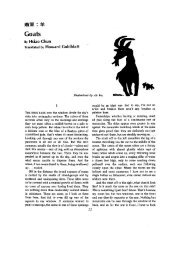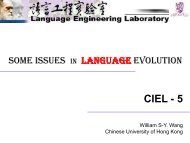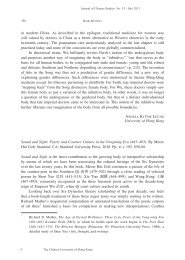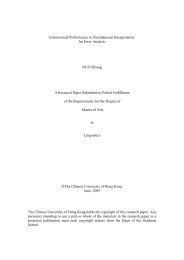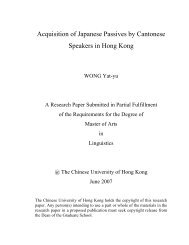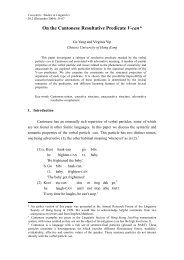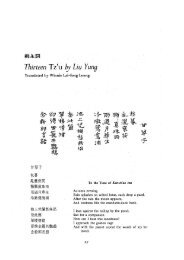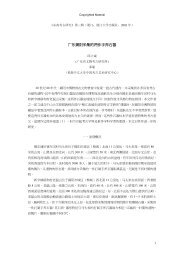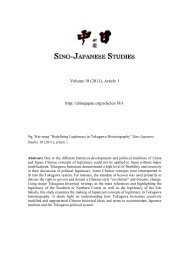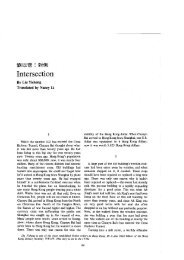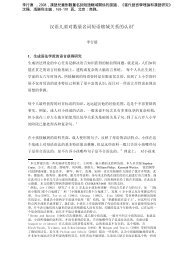A Systematic Study of the Degree Adverb ' beir ' in Tianjin Dialect
A Systematic Study of the Degree Adverb ' beir ' in Tianjin Dialect
A Systematic Study of the Degree Adverb ' beir ' in Tianjin Dialect
You also want an ePaper? Increase the reach of your titles
YUMPU automatically turns print PDFs into web optimized ePapers that Google loves.
A <strong>Systematic</strong> <strong>Study</strong> <strong>of</strong> <strong>Degree</strong> <strong>Adverb</strong> ‘<strong>beir</strong>’<br />
<strong>in</strong> Tianj<strong>in</strong> <strong>Dialect</strong><br />
He Jia<br />
A Research Paper Submitted <strong>in</strong> Partial Fulfilment<br />
<strong>of</strong> <strong>the</strong> Requirements for <strong>the</strong> <strong>Degree</strong> <strong>of</strong><br />
Master <strong>of</strong> Arts<br />
<strong>in</strong><br />
L<strong>in</strong>guistics<br />
©The Ch<strong>in</strong>ese University <strong>of</strong> Hong Kong<br />
June 2005<br />
The Ch<strong>in</strong>ese University <strong>of</strong> Hong Kong holds <strong>the</strong> copyright <strong>of</strong> this Research<br />
Paper. Any person(s) <strong>in</strong>tend<strong>in</strong>g to use a part or whole <strong>of</strong> <strong>the</strong> materials <strong>in</strong> <strong>the</strong><br />
Research Paper <strong>in</strong> a proposed publication must seek copyright release from<br />
<strong>the</strong> Dean <strong>of</strong> <strong>the</strong> Graduate School.
Table <strong>of</strong> Contents<br />
Abstract………………………………………………………………………………...i<br />
Acknowledgement…………………………………………………………………….ii<br />
Chapter One<br />
Introduction…………………………………………………………..1<br />
Chapter Two Literature Review……………………………………………………..2<br />
2.1 Intensity………………………………………………………………………2<br />
2.1.1 Means <strong>of</strong> Intensification………………………………………………2<br />
2.1.2 Intensification and Affective Mean<strong>in</strong>g………………………………..2<br />
2.2 Etymology <strong>of</strong> Beir……………………………………………………………3<br />
2.3 Motivation <strong>of</strong> <strong>the</strong> Emergence <strong>of</strong> <strong>beir</strong> <strong>in</strong> Tianj<strong>in</strong> <strong>Dialect</strong>……………………..5<br />
2.4 Grammaticalization <strong>of</strong> Hen <strong>in</strong> Mandar<strong>in</strong>…………………………………….7<br />
Chapter Three<br />
Syntactic Property <strong>of</strong> Beir…………………………………………...8<br />
3.1 Syntactic Similarities between <strong>beir</strong> and hen …………………………………8<br />
3.1.1 <strong>beir</strong>/hen+ Adjectival Phrase …………………………………………..8<br />
3.1.2 <strong>beir</strong>/hen+ Verbal Phrase……………………………………………….9<br />
3.1.3 <strong>beir</strong>/hen+Noun Phrase……………………………………………….11<br />
3.2 Syntactic Differences ……………………………………………………….12<br />
Chapter Four<br />
Semantic Features <strong>of</strong> Beir…………………………………………...14<br />
4.1 Semantic Feature <strong>of</strong> <strong>beir</strong>…………………………………………………….14<br />
4.1.1 Distribution <strong>of</strong> <strong>Degree</strong> Modifiers <strong>in</strong> Traditional Grammar………….14<br />
4.1.2 New Schema for Ch<strong>in</strong>ese <strong>Degree</strong> Modifiers………………………...16<br />
4.2 Gradability…………………………………………………………………..17<br />
4.3 Adjectives Phrases that could be modified by <strong>beir</strong>………………………….18<br />
4.3.1 Classification <strong>of</strong> Adjectives …………………………………………18<br />
4.3.2 Semantic Feature <strong>of</strong> Negated Adjectives Modified by <strong>beir</strong>…………23<br />
4.4 Semantic Features <strong>of</strong> Verb Phrases Modified by Beir………………………26<br />
4.4.1 Classification <strong>of</strong> Verb Phrases……………………………………….26<br />
4.4.2 Semantic features <strong>of</strong> V <strong>in</strong> <strong>beir</strong>+VO………………………………….32<br />
4.4.3 Co-occurrence <strong>of</strong> Beir with Gradable Morphemes <strong>in</strong> Verb Phrases...33
4.5 Semantic Differences between <strong>beir</strong> and hen………………………………..36<br />
Chapter Five Conclusion…………………………………………………………...41<br />
References……………………………………………………………………… ……42
Abstract<br />
Beir is a newly emerged degree modifier <strong>in</strong> Tianj<strong>in</strong>, a dialect <strong>of</strong> Ch<strong>in</strong>ese,<br />
which bears similar mean<strong>in</strong>g ‘very’ with <strong>the</strong> degree adverb hen <strong>in</strong> Mandar<strong>in</strong>. Beir is<br />
derived from bei, which bears <strong>the</strong> mean<strong>in</strong>g <strong>of</strong> time and <strong>in</strong>tensify. It came <strong>in</strong>to be<strong>in</strong>g <strong>in</strong><br />
<strong>the</strong> 1960s and now is widely used <strong>in</strong> people’s daily life <strong>in</strong> Tianj<strong>in</strong>. The aim <strong>of</strong> <strong>the</strong><br />
present study is to give a general description <strong>of</strong> <strong>the</strong> l<strong>in</strong>guistic properties <strong>of</strong> <strong>beir</strong> <strong>in</strong><br />
order to show its new functions and characteristics as an evidence for <strong>the</strong><br />
development <strong>of</strong> degree modifiers.<br />
The present study <strong>in</strong>vestigates <strong>the</strong> properties <strong>of</strong> <strong>beir</strong> as an absolute degree<br />
modifier, which functionally falls <strong>in</strong>to <strong>the</strong> category <strong>of</strong> boosters <strong>in</strong> re<strong>in</strong>forcers as<br />
proposed <strong>in</strong> this paper. It also explores <strong>the</strong> constra<strong>in</strong>ts that govern <strong>the</strong> harmony<br />
between <strong>beir</strong> and <strong>the</strong> adjectival phrases, verb phrases and noun phrases that it<br />
modifies. A new schema is proposed to classify adjectives that could be modified by<br />
degree modifiers <strong>in</strong> Ch<strong>in</strong>ese accord<strong>in</strong>g to <strong>the</strong>ir gradability. It is also argued <strong>in</strong> this<br />
paper that aspectually only stative verb phrases can be modified by <strong>beir</strong>. F<strong>in</strong>ally, <strong>the</strong><br />
semantic differences between <strong>beir</strong> and hen are highlighted <strong>in</strong> terms <strong>of</strong> <strong>the</strong>ir etymology,<br />
syntactic function and semantic scope.<br />
- i -
Acknowledgement<br />
First, my most s<strong>in</strong>cere thanks go to Pr<strong>of</strong>essor Gu Yang for her teach<strong>in</strong>g me <strong>the</strong><br />
essential concepts <strong>of</strong> syntax and semantics and supervis<strong>in</strong>g my <strong>the</strong>sis with utmost<br />
k<strong>in</strong>dness and pa<strong>in</strong>stak<strong>in</strong>g care. When I first came to Hong Kong, she gave me lots <strong>of</strong><br />
help <strong>in</strong> teach<strong>in</strong>g me how to get used to <strong>the</strong> life here.<br />
I would also like to express my gratitude to Pr<strong>of</strong>essor Yap Foong-ha for help<strong>in</strong>g<br />
me look for <strong>the</strong> data that I needed most, also to Pr<strong>of</strong>essor Gu Gang <strong>in</strong> Tianj<strong>in</strong> Normal<br />
University for arous<strong>in</strong>g my <strong>in</strong>terest <strong>in</strong> study<strong>in</strong>g l<strong>in</strong>guistics, especially syntax, when I<br />
was an undergraduate. Besides, my gratitude also goes to all pr<strong>of</strong>essors and staffs <strong>in</strong><br />
our department for <strong>the</strong>ir help.<br />
F<strong>in</strong>ally, I would like to give my heartfelt gratitude to my parents and my<br />
grandparents for <strong>the</strong>ir love, support and encouragement.<br />
- ii -
Chapter One<br />
Introduction<br />
Tianj<strong>in</strong> is at <strong>the</strong> nor<strong>the</strong>rn end <strong>of</strong> <strong>the</strong> Grand Canal <strong>of</strong> Ch<strong>in</strong>a. People from<br />
urban Tianj<strong>in</strong> speak Tianj<strong>in</strong> dialect, which comes under <strong>the</strong> Mandar<strong>in</strong> subdivision <strong>of</strong><br />
spoken Ch<strong>in</strong>ese. Despite its proximity to Beij<strong>in</strong>g, Tianj<strong>in</strong> dialect sounds quite<br />
different from Beij<strong>in</strong>g dialect, which provides <strong>the</strong> basis for Mandar<strong>in</strong>, <strong>the</strong> <strong>of</strong>ficial<br />
spoken language <strong>in</strong> Ch<strong>in</strong>a.<br />
Beir is a typical degree adverb <strong>in</strong> Tianj<strong>in</strong> dialect. It was orig<strong>in</strong>ated from bei,<br />
which means time and <strong>in</strong>tensify. It came <strong>in</strong>to be<strong>in</strong>g <strong>in</strong> <strong>the</strong> early 20 th century and is<br />
now widely used <strong>in</strong> people’s daily life. This study conta<strong>in</strong>s a detailed descriptive<br />
account <strong>of</strong> <strong>the</strong> syntactic, semantic and some pragmatic properties <strong>of</strong> <strong>beir</strong> <strong>in</strong> Tianj<strong>in</strong><br />
dialect by compar<strong>in</strong>g it with hen, a popular degree adverb <strong>in</strong> Mandar<strong>in</strong> which bears<br />
similar mean<strong>in</strong>g to ‘very’.<br />
Chapter Two first <strong>in</strong>troduces <strong>the</strong> basic notion <strong>of</strong> <strong>in</strong>tensity and means <strong>of</strong><br />
<strong>in</strong>tensification, <strong>the</strong>n gives a general account <strong>of</strong> <strong>the</strong> etymology <strong>of</strong> <strong>beir</strong> <strong>in</strong> Tianj<strong>in</strong> dialect.<br />
Chapter Three deals with <strong>the</strong> syntactic properties <strong>of</strong> <strong>beir</strong> by way <strong>of</strong> compar<strong>in</strong>g it with<br />
hen. Chapter Four postulates a detailed description <strong>of</strong> semantic property <strong>of</strong> not only<br />
<strong>beir</strong> <strong>in</strong> Tianj<strong>in</strong> dialect but also <strong>the</strong> phrases that it modifies.<br />
- 1 -
Chapter Two Literature Review<br />
2.1 Intensity<br />
Language has <strong>the</strong> property <strong>of</strong> specify<strong>in</strong>g various degrees by means <strong>of</strong> a set <strong>of</strong><br />
degree modifiers. For example, one can conceive <strong>of</strong> ‘tallness’ as a semantic dimension<br />
<strong>in</strong> <strong>the</strong> form <strong>of</strong> graded scale rang<strong>in</strong>g from be<strong>in</strong>g tall to <strong>the</strong> extreme to be<strong>in</strong>g short to <strong>the</strong><br />
extreme, and <strong>in</strong> between <strong>the</strong> two extremes an almost unlimited number <strong>of</strong> degrees.<br />
Say, <strong>in</strong> English we say: skyscrap<strong>in</strong>g tall, very tall, fairly tall, not so tall, etc. In<br />
Ch<strong>in</strong>ese, we say: jigao (extremely tall), hengao (very tall), youdian gao (a little bit<br />
tall), buhen gao (not so tall) etc. Accord<strong>in</strong>g to Lak<strong>of</strong>f (1972), <strong>in</strong>tensity <strong>in</strong> language<br />
differs from <strong>in</strong>tensity <strong>in</strong> physics, <strong>in</strong> that it cannot be measured objectively. The degree<br />
is always measured or estimated <strong>in</strong> subjective norm relative to <strong>the</strong> speaker’s<br />
experience: a very tall girl as judged by Pygmy standards may actually be a ra<strong>the</strong>r<br />
short girl by European standards.<br />
2.1.1 Means <strong>of</strong> Intensification<br />
Vermeire (1979) argues that degree <strong>in</strong>tensifiers allow expression <strong>of</strong> many shades<br />
<strong>of</strong> mean<strong>in</strong>g without <strong>the</strong> need for <strong>the</strong> lexicon to provide an equally large number <strong>of</strong><br />
appropriate terms. But <strong>the</strong> existence <strong>of</strong> degree modifiers <strong>in</strong> language has not<br />
precluded <strong>the</strong> development <strong>of</strong> separate items <strong>in</strong>dicat<strong>in</strong>g various degrees <strong>of</strong> quality on<br />
a semantic dimension: <strong>the</strong>re is a scale, e.g. huge-big-small-t<strong>in</strong>y, or<br />
adore-love-like-dislike-hate-loa<strong>the</strong>, more or less co<strong>in</strong>cid<strong>in</strong>g with extremety, e.g.<br />
big…very small, or love deeply…hate deeply, etc. The devices for <strong>in</strong>tensification <strong>in</strong><br />
language are manifold, degree modifiers be<strong>in</strong>g only one <strong>of</strong> <strong>the</strong>m.<br />
2.1.2 Intensification and Affective Mean<strong>in</strong>g<br />
Intensifiers always <strong>in</strong>volve emotions <strong>in</strong> <strong>the</strong>ir pragmatic implications, <strong>in</strong> that <strong>the</strong>y<br />
always convey some emotional attitudes <strong>of</strong> <strong>the</strong> speaker towards <strong>the</strong> predication apart<br />
- 2 -
from <strong>the</strong> primary mean<strong>in</strong>g. For <strong>in</strong>stance, hen <strong>in</strong> Mandar<strong>in</strong> is a ra<strong>the</strong>r neutral and not<br />
very strong degree <strong>in</strong>tensifier, but <strong>beir</strong> <strong>in</strong> Tianj<strong>in</strong> dialect and hao <strong>in</strong> Guangdong<br />
dialect even <strong>the</strong> newly emerged ones such as j<strong>in</strong>, bao <strong>in</strong> Cantonese are emotionally<br />
loaded and carry a ra<strong>the</strong>r strong effect. Accord<strong>in</strong>g to Vermeire (1979), strength is<br />
related to <strong>the</strong> emotional load<strong>in</strong>g, which is related to novelty <strong>of</strong> <strong>the</strong> expression. So if a<br />
degree adverb has not been pr<strong>of</strong>oundly used, it will have a significant affective<br />
connotation.<br />
2.2 Etymology <strong>of</strong> Beir<br />
Accord<strong>in</strong>g to Ch<strong>in</strong>ese dictionaries: Xiandai Hanyu Cidian (1961,1980:18),<br />
Cihai (1979: 579) and Xiandai Hanyu Guifan Cidian, ‘<strong>beir</strong>’ has <strong>the</strong> follow<strong>in</strong>g uses:<br />
1. A verb, bear<strong>in</strong>g <strong>the</strong> mean<strong>in</strong>g <strong>of</strong> doubl<strong>in</strong>g <strong>in</strong> quantity <strong>in</strong> Pre-Q<strong>in</strong> (Cihai: 579):<br />
(1) 故 事 半 古 之 人 , 功 必 倍 之 。<br />
Gu shi ban gu zhi ren, gong bi bei zhi<br />
so mater half ancient de people, result must<br />
double it<br />
‘So <strong>the</strong> th<strong>in</strong>g is that you do half <strong>of</strong> <strong>the</strong> work, <strong>the</strong> result will double.’<br />
Zhi is <strong>the</strong> resumptive pronoun, which takes gong as its antecedent. Gong is<br />
topicalized <strong>in</strong> this case. Bei functions as a verb, which bears <strong>the</strong> mean<strong>in</strong>g <strong>of</strong> double.<br />
So beizhi is a verb phrase, which means to double <strong>the</strong> result.<br />
- 3 -
2. A verb, which bears <strong>the</strong> mean<strong>in</strong>g <strong>of</strong> mak<strong>in</strong>g pr<strong>of</strong>its for (Cihai: 579)<br />
(2) 焉 用 亡 郑 以 倍 邻 ? (Zuozhuan, Xigong Thirtieth Year <strong>in</strong> Pre-Q<strong>in</strong>)<br />
Yanyong wang zheng yi bei l<strong>in</strong><br />
use<br />
dead Zheng to pr<strong>of</strong>it neighbour<br />
‘Why use <strong>the</strong> destroyed Zheng to make pr<strong>of</strong>its for <strong>the</strong> neighbour<strong>in</strong>g nation?’<br />
Bei is still a verb here, which means to make pr<strong>of</strong>its for. L<strong>in</strong>, which means <strong>the</strong><br />
neighbor<strong>in</strong>g country, serves as <strong>the</strong> object <strong>of</strong> bei. So beil<strong>in</strong> is a verb phrase that takes<br />
on <strong>the</strong> structure <strong>of</strong> VO.<br />
3. An adverb modify<strong>in</strong>g a verb phrase which bears <strong>the</strong> mean<strong>in</strong>g <strong>of</strong> “very much”<br />
(Cihai: 579):<br />
(3) 每 逢 佳 节 倍 思 亲 。 1<br />
mei feng jiajie bei si q<strong>in</strong><br />
every when festival very much miss<br />
relatives<br />
‘whenever <strong>the</strong> festival comes, I miss my relatives very much.’<br />
Bei here serves as a degree adverb with <strong>the</strong> mean<strong>in</strong>g <strong>of</strong> very much, which<br />
directly modifies <strong>the</strong> verb phrase siq<strong>in</strong>(miss relatives).<br />
4. An adverb bear<strong>in</strong>g <strong>the</strong> function <strong>of</strong> <strong>in</strong>tensify<strong>in</strong>g <strong>the</strong> degree <strong>of</strong> <strong>the</strong> adjective be<strong>in</strong>g<br />
modified. For example: ‘<strong>beir</strong> liang’ means very bright. (Xiandai Hanyu Cidian<br />
1961:18)<br />
5. Beir is a dialectal degree modifier, which bears <strong>the</strong> mean<strong>in</strong>g <strong>of</strong> fairly and very. E.g.<br />
<strong>beir</strong> x<strong>in</strong>: very new, <strong>beir</strong> liang: very bright, <strong>beir</strong> j<strong>in</strong>gshen: very energetic.(Xiandai<br />
1 It is cited from <strong>the</strong> famous poem: Jiuyuejiuri Yi Shandong Xiongdi (In memory <strong>of</strong> my bro<strong>the</strong>r <strong>in</strong> Shandong on<br />
September <strong>the</strong> n<strong>in</strong>th), which is written by WangWei <strong>in</strong> Tsang Dyansty.<br />
- 4 -
Hanyu Cidian 1980: 18)<br />
Xiandai Hanyu Cidian that was published before 1961 didn’t <strong>in</strong>clude <strong>the</strong> item<br />
<strong>of</strong> <strong>beir</strong> <strong>in</strong> Tianj<strong>in</strong> dialect, which functions as a degree adverb that modifies adjectives.<br />
This <strong>in</strong>dicates that <strong>the</strong> adverbial <strong>beir</strong> that modifies adjectives does not have a long<br />
history <strong>in</strong> Tianj<strong>in</strong>. It may came <strong>in</strong>to be<strong>in</strong>g around <strong>the</strong> 1960s. But it is now widely used<br />
<strong>in</strong> people’s everyday conversation. As seen <strong>in</strong> 1-5, accord<strong>in</strong>g to Cihai and <strong>the</strong> CHANT<br />
Database, <strong>beir</strong> used to be a verb mean<strong>in</strong>g to double <strong>in</strong> Pre-Q<strong>in</strong> Dynasty, but <strong>in</strong> Tang<br />
Dynasty, it was used as an adverb that encoded <strong>the</strong> mean<strong>in</strong>g <strong>of</strong> <strong>in</strong>tensity, however, it<br />
can only modify verb phrase syntactically. Now <strong>beir</strong> has become a degree modifier<br />
that has <strong>the</strong> ability to modify not only verb phrases but adjectives and nouns as well,<br />
for <strong>in</strong>stance, <strong>beir</strong> liang (very bright), <strong>beir</strong> x<strong>in</strong> (very new), <strong>beir</strong> zhongguo (behave like<br />
a Ch<strong>in</strong>ese very much), beier shudaizi (behave like a gr<strong>in</strong>d) etc.<br />
2.3 Motivation <strong>of</strong> <strong>the</strong> Emergence <strong>of</strong> <strong>beir</strong> <strong>in</strong> Tianj<strong>in</strong> <strong>Dialect</strong><br />
Accord<strong>in</strong>g to Hopper and Traugott (2003: 122), exist<strong>in</strong>g forms take on new<br />
mean<strong>in</strong>gs <strong>in</strong> certa<strong>in</strong> contexts, while reta<strong>in</strong><strong>in</strong>g old mean<strong>in</strong>gs <strong>in</strong> o<strong>the</strong>r contexts. This<br />
phenomenon is known as renewal. Renewal results primarily <strong>in</strong> alternate ways <strong>of</strong><br />
organiz<strong>in</strong>g l<strong>in</strong>guistic material. Intensifiers are subject to renewal, presumably because<br />
<strong>of</strong> <strong>the</strong>ir marked emotional function. It is unusual that <strong>the</strong>y undergo renewal frequently.<br />
In English, at different times <strong>in</strong> <strong>the</strong> last two centuries, <strong>the</strong> follow<strong>in</strong>g degree<br />
<strong>in</strong>tensifiers have been frequently used: awfully, frightfully, fearfully, terribly,<br />
<strong>in</strong>credibly, really, <strong>in</strong>credibly, really, pretty, truly etc. Even <strong>in</strong> formal register, ‘very’<br />
<strong>of</strong>ten alternates with such words as ‘most, surpris<strong>in</strong>gly, extremely, highly,<br />
extraord<strong>in</strong>arily, etc.’ So is <strong>the</strong> case <strong>in</strong> Ch<strong>in</strong>ese. Liu (2001) gave us a brief outl<strong>in</strong>e <strong>of</strong><br />
renewal <strong>of</strong> <strong>in</strong>tensifier <strong>in</strong> Ch<strong>in</strong>ese as follows:<br />
- 5 -
da (Shang Dynasty) kong (Zhou Dynasty) shen (<strong>the</strong> Pre-Q<strong>in</strong><br />
Period)shu (Mid Ancient) feichang (<strong>the</strong> Tang Dynasty)hen (Modern<br />
Time) O<strong>the</strong>r <strong>Dialect</strong>al <strong>Degree</strong> Modifiers<br />
There is only one degree <strong>in</strong>tensifier <strong>in</strong> <strong>the</strong> <strong>in</strong>scriptions on oracle bones (16 th<br />
B.C.). Not until <strong>the</strong> Zhou Dynasty (11 th .B.C.) did o<strong>the</strong>r degree modifiers beg<strong>in</strong> to<br />
emerge. For <strong>in</strong>stance, kong (very). When it comes to <strong>the</strong> Pre-Q<strong>in</strong> Period (722<br />
B.C.—221 B.C.), shen, which is ano<strong>the</strong>r <strong>in</strong>tensifier, came <strong>in</strong>to be<strong>in</strong>g. But it was used<br />
as an adjective ra<strong>the</strong>r than an adverb. In Mid-ancient time (221 B.C.—589 A.D.), shu<br />
(very) emerged and was frequently used at that time. But now it only appears <strong>in</strong><br />
ancient articles. In <strong>the</strong> Tang Dynasty (618 A.D.—907 A.D.), feichang appeared as an<br />
adjective, not until recently has it become a degree adverb. In modern times (1912<br />
A.D.—Present), 很 (very) could be written as 狠 (fiercely), which <strong>in</strong>dicates <strong>the</strong><br />
function <strong>of</strong> emphasiz<strong>in</strong>g, but later it became a basic degree adverb. Now we only use<br />
很 (very), <strong>in</strong>stead <strong>of</strong> 狠 (fiercely), when referr<strong>in</strong>g to <strong>the</strong> function <strong>of</strong> degree adverb.<br />
But <strong>the</strong> renewal <strong>of</strong> <strong>in</strong>tensifier hasn’t stopped. <strong>Dialect</strong>al degree modifier is a good<br />
piece <strong>of</strong> evidence to account for this phenomenon. For <strong>in</strong>stance: Zei (very) <strong>in</strong> <strong>the</strong><br />
Nor<strong>the</strong>ast <strong>Dialect</strong>, Tei (very) <strong>in</strong> Beij<strong>in</strong>g dialect, Beir (very) <strong>in</strong> Tianj<strong>in</strong> dialect or even<br />
<strong>the</strong> newly emerged ‘J<strong>in</strong> (extremely), Chao (superbly), Bao (Extraord<strong>in</strong>arily)’ <strong>in</strong><br />
Cantonese. Ra<strong>the</strong>r than replac<strong>in</strong>g <strong>the</strong> old expressions, <strong>the</strong> newly <strong>in</strong>novated forms<br />
compete with older ones because <strong>the</strong>y are more expressive than what was available<br />
before. So compared with hen <strong>in</strong> Mandar<strong>in</strong>, <strong>the</strong> dialectal degree <strong>in</strong>tensifiers such as tei<br />
<strong>in</strong> Beij<strong>in</strong> dialect, <strong>beir</strong> <strong>in</strong> Tianj<strong>in</strong> dialect and zei <strong>in</strong> Nor<strong>the</strong>ast dialect, etc. seem to have<br />
a stronger emotional flavor. For <strong>in</strong>stance, when we say ‘Zhei ren <strong>beir</strong> niu.’ (This man<br />
is excellent.), it <strong>in</strong>corporates a strong sense <strong>of</strong> admiration subjectively <strong>in</strong> terms <strong>of</strong> <strong>the</strong><br />
speaker. This competition allows, even encourages, <strong>the</strong> recession or loss <strong>of</strong> older<br />
forms. So <strong>in</strong> <strong>the</strong> future, <strong>the</strong> currently frequently used degree modifier hen could<br />
possibly be substituted by <strong>the</strong> dialectal ones through <strong>the</strong> process <strong>of</strong> competition.<br />
- 6 -
2.4 Grammaticalization <strong>of</strong> Hen <strong>in</strong> Mandar<strong>in</strong><br />
Hen, which bears similar mean<strong>in</strong>g with <strong>beir</strong> is a popular degree modifier <strong>in</strong><br />
Mandar<strong>in</strong>. Accord<strong>in</strong>g to Chui (2000), hen is undergo<strong>in</strong>g a process <strong>of</strong> semantic change<br />
to develop <strong>in</strong>to a bound constituent from a free <strong>in</strong>dependent word by way <strong>of</strong><br />
ciliticization and compound<strong>in</strong>g. In <strong>the</strong> first stage <strong>of</strong> development, Hen is a degree<br />
adverb; its gradable extent is higher than average sense. In <strong>the</strong> second stage, it loses<br />
morphosytactic autonomy and develops <strong>in</strong>to a clitic, be<strong>in</strong>g bound to <strong>the</strong> adjacent<br />
scalar predicate. F<strong>in</strong>ally, Hen becomes a compound constituent, as a result <strong>of</strong><br />
amalgamat<strong>in</strong>g <strong>the</strong> clitic form and its adjacent verb. So <strong>the</strong> grammaticalization <strong>of</strong> Hen<br />
<strong>in</strong>dicates that its encoded emotion is s<strong>of</strong>tened through <strong>the</strong> process <strong>of</strong> history.<br />
Develop<strong>in</strong>g new forms with similar mean<strong>in</strong>g such as <strong>beir</strong> <strong>in</strong> Tianj<strong>in</strong> dialect is<br />
motivated by <strong>the</strong> necessity <strong>of</strong> new emotional concepts for communication.<br />
- 7 -
Chapter Three<br />
Syntactic Property <strong>of</strong> Beir<br />
Hen is a degree modifier, which is frequently used <strong>in</strong> Mandar<strong>in</strong>. Beir, which<br />
bears similar mean<strong>in</strong>g and function with hen, is a newly emerged degree modifier <strong>in</strong><br />
Tianj<strong>in</strong> dialect. Although it does not have so long a history as hen, it has its unique<br />
properties and new functions that could not be found <strong>in</strong> hen. Beir is so popular now<br />
that it even attracts a lot <strong>of</strong> people from <strong>the</strong> neighbor<strong>in</strong>g city Beij<strong>in</strong>g <strong>in</strong>to us<strong>in</strong>g it. The<br />
common features as well as <strong>the</strong> differences between <strong>the</strong> two will be illustrated <strong>in</strong> an<br />
attempt to give a general outl<strong>in</strong>e <strong>of</strong> <strong>the</strong> mean<strong>in</strong>g and function <strong>of</strong> <strong>beir</strong> <strong>in</strong> Tianj<strong>in</strong><br />
dialect.<br />
3.1 Syntactic Similarities between <strong>beir</strong> and hen<br />
S<strong>in</strong>ce people from o<strong>the</strong>r places <strong>in</strong> Ch<strong>in</strong>a are not familiar with <strong>the</strong> function and<br />
syntactic properties <strong>of</strong> <strong>the</strong> degree modifier <strong>beir</strong> <strong>in</strong> Tianj<strong>in</strong> dialect, however, <strong>the</strong> degree<br />
adverb hen is widely used <strong>in</strong> Mandar<strong>in</strong>, <strong>the</strong> follow<strong>in</strong>g part will highlight <strong>the</strong> syntactic<br />
similarities between hen and <strong>beir</strong> <strong>in</strong> an attempt to get people acqua<strong>in</strong>ted with it.<br />
3.1.1 <strong>beir</strong>/hen+ Adjectival Phrase<br />
There are two types <strong>of</strong> adjectival phrases that could be modified by <strong>beir</strong> and hen,<br />
one is bare adjectives that modified by <strong>beir</strong> and hen, <strong>the</strong> o<strong>the</strong>r is negated form <strong>of</strong><br />
adjectival phrases modified by <strong>beir</strong> and hen.<br />
1. Bare adjectives modified by <strong>beir</strong> and hen.<br />
(4) 倍 儿 / 很 开 心<br />
<strong>beir</strong>/hen kaix<strong>in</strong><br />
very<br />
happy<br />
‘very happy’<br />
- 8 -
Kaix<strong>in</strong> is a bare adjective with <strong>the</strong> mean<strong>in</strong>g happy. Beir and hen serve as degree<br />
adverbs, which directly modify kaix<strong>in</strong>.<br />
2. Negated form <strong>of</strong> adjectival phrases modified by <strong>beir</strong> and hen.<br />
(5) 倍 儿 / 很 不 诚 实<br />
<strong>beir</strong>/hen bu chengshi<br />
very<br />
not honest<br />
‘very dishonest’<br />
Bu bears <strong>the</strong> mean<strong>in</strong>g <strong>of</strong> not, so buchengshi is <strong>the</strong> negated form <strong>of</strong> chengshi.<br />
Beir and hen serve as degree adverbs, which modify <strong>the</strong> negated adjectival phrase.<br />
3.1.2 <strong>beir</strong>/hen+ Verbal Phrase<br />
There are five types <strong>of</strong> structures <strong>of</strong> verbal phrase that can be modified by <strong>beir</strong><br />
and hen. For example:<br />
1. Intransitive verb phrases modified by <strong>beir</strong> and hen:<br />
(6) 倍 儿 / 很 愿 意<br />
<strong>beir</strong>/hen yuanyi<br />
very<br />
wish<br />
‘wish very much’<br />
Yuanyi is an <strong>in</strong>transitive verb, which bears <strong>the</strong> mean<strong>in</strong>g <strong>of</strong> wish. In this case,<br />
Beir and hen serve as <strong>the</strong> degree adverbs that modify an <strong>in</strong>transitive verb phrase.<br />
- 9 -
2. Transitive verb phrases modified by <strong>beir</strong> and hen.<br />
(7) 倍 儿 / 很 支 持 你 (VO structure)<br />
<strong>beir</strong>/hen zhichi ni<br />
very support you<br />
‘support you very much’<br />
Zhichi is a transitive verb, which bears <strong>the</strong> mean<strong>in</strong>g <strong>of</strong> support. Ni with <strong>the</strong><br />
mean<strong>in</strong>g you is <strong>the</strong> object <strong>of</strong> zhichi. So <strong>the</strong> whole phrase turns out to be VO <strong>in</strong><br />
structure. Beir and hen serve as degree adverbs, which modify a transitive verb<br />
phrase.<br />
3. Negated form <strong>of</strong> verb phrases modified by <strong>beir</strong> and hen.<br />
(8) 倍 儿 / 很 不 愿 意<br />
<strong>beir</strong>/hen bu yuanyi<br />
very<br />
not wish<br />
‘very unwill<strong>in</strong>g’<br />
Buyuanyi is <strong>the</strong> negated form <strong>of</strong> yuanyi. Beir and hen serve as degree adverbs<br />
that modify <strong>the</strong> negated form <strong>of</strong> <strong>in</strong>transitive verb phrases.<br />
4. Causative structure modified by <strong>beir</strong> and hen<br />
(9) 倍 儿 / 很 讨 人 喜 欢<br />
<strong>beir</strong>/hen tao ren xihuan<br />
very<br />
make people like<br />
‘very lovely’<br />
- 10 -
Tao is a causative verb, which bears <strong>the</strong> mean<strong>in</strong>g <strong>of</strong> make. Ren is <strong>the</strong> direct<br />
object <strong>of</strong> tao. Xihuan is a verb with <strong>the</strong> mean<strong>in</strong>g like. The whole phrase turns out to<br />
be a causative structure. Beir and hen could have <strong>the</strong> function <strong>of</strong> modify<strong>in</strong>g causative<br />
verb phrases.<br />
5. Negated causative structure modified by beier and hen<br />
(10) 倍 儿 / 很 不 讨 人 喜 欢<br />
beier/hen bu tao ren xihuan<br />
very<br />
not make people like<br />
very annoy<strong>in</strong>g<br />
Bu followed by <strong>the</strong> causative verb phrase that I have mentioned above is <strong>the</strong><br />
negated form <strong>of</strong> it. So bei and hen serve as degree adverbs that modify <strong>the</strong> negated<br />
form <strong>of</strong> causative verb phrases.<br />
3.1.3 <strong>beir</strong>/hen+Noun Phrase<br />
Nouns are always seen as <strong>in</strong>herently nongradable words. They are absolute <strong>in</strong><br />
mean<strong>in</strong>g and have no implicit scale. However, nowadays certa<strong>in</strong> types <strong>of</strong> noun<br />
phrases can be modified by degree adverbs <strong>in</strong> Ch<strong>in</strong>ese. In this case, <strong>the</strong> noun phrase<br />
always <strong>in</strong>dicates <strong>the</strong> property <strong>of</strong> an event or state. It is worth not<strong>in</strong>g that referential<br />
noun phrases usually cannot co-occur with degree modifiers. For example:<br />
(11) 倍 儿 / 很 中 国<br />
<strong>beir</strong>/hen zhongguo<br />
very<br />
Ch<strong>in</strong>ese<br />
‘behave like a Ch<strong>in</strong>ese very much’<br />
- 11 -
(12) 倍 儿 / 很 书 呆 子<br />
<strong>beir</strong>/hen shudaizi<br />
very<br />
bookworm<br />
‘one can do noth<strong>in</strong>g but study’<br />
Vermeire(1979) argued that nongradable multiple taxonomy words, such as<br />
British and memory, can be relativized if used <strong>in</strong> a specific sense. Examples can be<br />
cited from English:<br />
(13) He is very British.<br />
(14) You have quite a memory.<br />
In <strong>the</strong>se cases, ‘British’ and ‘memory’ refer to aspects or style <strong>of</strong> behav<strong>in</strong>g or<br />
be<strong>in</strong>g like British or short <strong>of</strong> memory. So no dist<strong>in</strong>ctive l<strong>in</strong>e can be drawn between <strong>the</strong><br />
gradables and <strong>the</strong> nongradables, s<strong>in</strong>ce even <strong>the</strong> absolute nouns that do not <strong>in</strong>corporate<br />
<strong>the</strong> sense <strong>of</strong> degree can be relativized <strong>in</strong> everyday speech. For example:<br />
(15) 她 倍 儿 女 人 。<br />
Ta <strong>beir</strong> nuren.<br />
she very woman<br />
‘She is sexual.’<br />
The orig<strong>in</strong>al mean<strong>in</strong>g <strong>of</strong> ‘ 女 人 ’(woman) changed from woman to be<strong>in</strong>g sexual,<br />
but <strong>the</strong> form rema<strong>in</strong>s like a nongradable noun.<br />
3.2 Syntactic Differences<br />
There are two types <strong>of</strong> structure that can be modified by hen, but could not be<br />
modified by <strong>beir</strong>.<br />
- 12 -
The first is that hen could co-occur with numerals, but <strong>beir</strong> cannot. For example:<br />
(16) 她 * 倍 儿 / 很 睡 了 一 会 儿 。<br />
Ta *<strong>beir</strong>/hen shui le yihuir<br />
she<br />
very sleep LE a while<br />
‘She slept for quite a while.’<br />
(17) 她 * 倍 儿 / 很 买 了 几 本 书 。<br />
Ta *<strong>beir</strong>/hen mai le jiben shu<br />
she very buy Le several books<br />
‘She bought several books’<br />
Hen can modify <strong>the</strong> activity verb phrases that conta<strong>in</strong> unbounded numerals such<br />
as yihui <strong>in</strong> (16) and jiben <strong>in</strong> (17), but <strong>beir</strong> cannot.<br />
The second is that hen can be negated by bu(not), but <strong>beir</strong> cannot. For example:<br />
(18) 她 * 不 倍 儿 / 不 很 舒 服 。<br />
Ta *bu<strong>beir</strong>/buhen shufu<br />
she *not <strong>beir</strong>/not hen comfortable<br />
‘She is not very comfortable.’<br />
Beir and hen have similar syntactic functions <strong>in</strong> modify<strong>in</strong>g noun phrases, verb<br />
phrases and adjectival phrases. However, syntactically speak<strong>in</strong>g, <strong>beir</strong> is different from<br />
hen, <strong>in</strong> that it could not cooccur with <strong>the</strong> verb phrases that conta<strong>in</strong> unbounded<br />
numeral <strong>in</strong> it. Also <strong>beir</strong> does not have <strong>the</strong> function <strong>of</strong> be<strong>in</strong>g negated by bu, whereas<br />
hen does.<br />
- 13 -
Chapter Four<br />
Semantic Features <strong>of</strong> Beir<br />
4.1 Semantic Feature <strong>of</strong> <strong>beir</strong><br />
A general outl<strong>in</strong>e <strong>of</strong> <strong>the</strong> syntactic patterns such as <strong>the</strong> types <strong>of</strong> noun phrases,<br />
verb phrases and adjectival phrases that can be modified by <strong>beir</strong> has been listed <strong>in</strong> last<br />
chapter. In order to achieve a better undertand<strong>in</strong>g <strong>of</strong> <strong>the</strong>m, <strong>the</strong> semantic explanation <strong>of</strong><br />
<strong>the</strong> l<strong>in</strong>guistic properties <strong>of</strong> <strong>beir</strong> and <strong>the</strong> phrases it modifies are needed to give a<br />
detailed account.<br />
4.1.1 Distribution <strong>of</strong> <strong>Degree</strong> Modifiers <strong>in</strong> Traditional Grammar<br />
In traditional grammar, scholars argue that degree modifiers <strong>in</strong> Ch<strong>in</strong>ese fall <strong>in</strong>to<br />
two categories: relative modifiers and absolute modifiers (Wang 1933; Ma 1988;<br />
Zhou 1995; Zhang 1997; Zhang 2002) Accord<strong>in</strong>g to Wang (1933), relative degree<br />
modifiers refer to <strong>the</strong> ones that <strong>in</strong>dicate <strong>the</strong> comparison among specific entities that<br />
have similar properties; absolute degree modifiers refer to those that do not have<br />
specific entities to compare with, but just a standard <strong>in</strong> one’s m<strong>in</strong>d. In each <strong>of</strong> <strong>the</strong>se<br />
categories, subdivisions can be made accord<strong>in</strong>g to <strong>the</strong> degree value that <strong>the</strong>y denote.<br />
Both differences and similarities among <strong>the</strong> members <strong>of</strong> <strong>the</strong> same category <strong>of</strong> degree<br />
modifiers were illustrated <strong>in</strong> Table 1 by Zhang (1997).<br />
Zhang (1997) argues that relative modifiers are more concrete than absolute<br />
degree modifiers <strong>in</strong> that <strong>the</strong>y have a concrete item to compare with. For <strong>in</strong>stance, Biqi<br />
Lisi, Zhangsan geng gao(Compared with Lisi, Zhangsan is taller.). Lisi is a concrete<br />
item, which is considered as a reference to be compared with by <strong>the</strong> speaker. So geng<br />
is a relative degree modifier. Beir <strong>in</strong> Tianj<strong>in</strong> dialect belongs to <strong>the</strong> absolute degree<br />
modifier. It has similar properties as hen, feichang <strong>in</strong> Mandar<strong>in</strong>. But compared with<br />
<strong>the</strong>m, <strong>beir</strong> is more emotional and subjective <strong>in</strong> nature, it seldom appears <strong>in</strong> formal<br />
- 14 -
occasions. But which level <strong>in</strong> <strong>the</strong> absolute degree modifier does <strong>beir</strong> belong to, s<strong>in</strong>ce<br />
<strong>beir</strong> has lower degree value than ji and jiqi, but has higher degree value than hen and<br />
feichang? So this traditional analysis lacks accuracy <strong>in</strong> degree value for <strong>the</strong> dialectal<br />
degree modifiers.<br />
Types <strong>of</strong> <strong>Degree</strong><br />
Modifier<br />
Relative <strong>Degree</strong><br />
Modifier<br />
<strong>Degree</strong><br />
Superlative<br />
High<br />
Moderate<br />
Examples<br />
最 (zui): <strong>the</strong> most<br />
格 外 (gewai), 更 (geng), 还<br />
(hai): more<br />
比 较 (bijiao), 较 为 (jiaowei):<br />
quite<br />
<strong>Degree</strong><br />
Modifiers<br />
Low 略 (lue), 稍 微 (shaowei):<br />
somewhat<br />
Superlative 非 常 (fenwai), 太 (tai), 万 分<br />
Absolute <strong>Degree</strong><br />
Modifier<br />
High<br />
(wanfen): perfectly<br />
顶 (d<strong>in</strong>g), 极 (ji), 极 其 (jiqi):<br />
ultimate<br />
Moderate 多 么 (duome), 非 常<br />
(feichang), 很 (hen), 十 分<br />
(shifen), 挺 (t<strong>in</strong>g), 相 当<br />
(xiangdang): very<br />
Low<br />
有 点 (youdian), 有 些 (youxie):<br />
a little<br />
Table 1. Traditional Analysis <strong>of</strong> <strong>Degree</strong> Modifiers<br />
- 15 -
4.1.2 New Schema for Ch<strong>in</strong>ese <strong>Degree</strong> Modifiers<br />
One motivation for adopt<strong>in</strong>g a new schema for Ch<strong>in</strong>ese degree modifiers is<br />
that <strong>the</strong> traditional analysis only <strong>in</strong>cludes <strong>the</strong> degree modifiers <strong>in</strong> Mandar<strong>in</strong>.<br />
Nowadays new expressions such as <strong>beir</strong> <strong>in</strong> Tianj<strong>in</strong> dialect and tei <strong>in</strong> Beij<strong>in</strong>g dialect etc.<br />
have also been adopted by Mandar<strong>in</strong> speakers. S<strong>in</strong>ce degree modifiers is an open class,<br />
some new items such as <strong>the</strong> dialectal ones has already come <strong>in</strong>to be<strong>in</strong>g, <strong>the</strong>re should<br />
be a development for <strong>the</strong> schema <strong>of</strong> traditional analysis on <strong>the</strong> purpose <strong>of</strong><br />
<strong>in</strong>corporat<strong>in</strong>g <strong>the</strong> newly emerged ones.<br />
Maximiser<br />
极 (ji), 极 其 (jiqi), 超 (chao), 爆<br />
Absolute<br />
Re<strong>in</strong>forcers<br />
(bao) : exclusively, extremely<br />
<strong>Degree</strong><br />
Modifiers<br />
Booster<br />
Moderator<br />
多 么 (duome), 非 常 (feichang),<br />
十 分 (shifen), 格 外 (gewai), 特<br />
(te), 好 (hao), 倍 儿 (<strong>beir</strong>), 贼<br />
(zei) : very much<br />
很 (hen), 挺 (t<strong>in</strong>g), 怪 (guai), 颇<br />
(po): very<br />
Attenuators<br />
有 点 (youdian) , 有 些 (youxie): slightly,<br />
somewhat, more or less<br />
Absolutor<br />
完 全 (wanquan) : absolutely<br />
Relative<br />
Re<strong>in</strong>forcers<br />
Superlative<br />
最 (zui): most<br />
<strong>Degree</strong><br />
Comparator<br />
更 (geng) , 比 较 (bijiao) , 还<br />
modifiers<br />
(hai) : more<br />
Attenuators<br />
稍 微 (shaowei), 稍 稍 (shaoshao) : a little<br />
Table 2. New Schema for Ch<strong>in</strong>ese <strong>Degree</strong> Modifiers<br />
Both absolute degree modifiers and relative degree modifiers can be divided<br />
<strong>in</strong>to re<strong>in</strong>forcers and attenuators, which is based on <strong>the</strong>ir functions. Re<strong>in</strong>forcers refer to<br />
- 16 -
<strong>the</strong> ones that have a streng<strong>the</strong>n<strong>in</strong>g function, whereas attenuators refer to <strong>the</strong> ones that<br />
have a slightly lower<strong>in</strong>g effect. As for <strong>the</strong> absolute degree modifier, re<strong>in</strong>forces can be<br />
fur<strong>the</strong>r divided <strong>in</strong>to three categories i.e. maximisers, boosters and moderators.<br />
Maximizers denote <strong>the</strong> upper extreme on <strong>the</strong> scale such as ji, chao and bao. Boosters<br />
denote a high degree on <strong>the</strong> scale, for <strong>in</strong>stance, te, shifen and <strong>the</strong> dialectal ones such<br />
as <strong>beir</strong> and zei. Most dialectal degree modifiers will fall <strong>in</strong>to <strong>the</strong>se two categories <strong>in</strong><br />
that dialectal degree modifiers usually have a strong emotional flavor and thus have a<br />
higher degree value. Moderator <strong>in</strong>dicates that <strong>the</strong> item, which degree modifiers apply<br />
to, expresses lower degree value than booster but higher degree value than attenuators.<br />
So <strong>in</strong> this diagram, we can see clearly <strong>the</strong> difference between <strong>the</strong> dialectal degree<br />
modifiers such as <strong>beir</strong> <strong>in</strong> Tianj<strong>in</strong> dialect and hen <strong>in</strong> Mandar<strong>in</strong>.<br />
4.2 Gradability<br />
Manifestations <strong>of</strong> degree have traditionally been associated with adjectives<br />
and adverbs, and <strong>the</strong> concept <strong>of</strong> degree has traditionally been dealt with <strong>in</strong> terms <strong>of</strong><br />
whe<strong>the</strong>r <strong>the</strong>y can undergo comparison or not (Chu 1999; Zhang 1997). Gradability<br />
has thus primarily been associated with <strong>the</strong>se two grammatical classes <strong>of</strong> words. The<br />
view that degree is associated with adjectives and adverbs is challenged by Sapir<br />
(1949) and Bol<strong>in</strong>ger (1967, 1972), who claim that gradability is not only a feature <strong>of</strong><br />
adjectives, but also that <strong>of</strong> nouns and verbs. All gradable words <strong>in</strong>volve a feature <strong>of</strong><br />
degree, which we perceive as variable <strong>in</strong> <strong>in</strong>tensity or extent, and which <strong>the</strong>refore can<br />
be attenuated or re<strong>in</strong>forced. In order to give a detailed description <strong>of</strong> <strong>the</strong> semantic<br />
feature <strong>of</strong> <strong>beir</strong>, we first need to have a look at <strong>the</strong> phrases that it could modify.<br />
- 17 -
4.3 Adjectives Phrases that could be Modified by Beir<br />
In this part, <strong>the</strong> classification <strong>of</strong> adjectival phrases will be conducted <strong>in</strong> order<br />
to give a clear explanation <strong>of</strong> <strong>the</strong> rule that govern <strong>the</strong> relationship between <strong>beir</strong> and<br />
<strong>the</strong> adjectives that it modifies. The semantic feature <strong>of</strong> <strong>the</strong> negated adjectives that<br />
could be modified by <strong>beir</strong> will also be discussed <strong>in</strong> this section.<br />
4.3.1 Classification <strong>of</strong> Adjectives<br />
Adjectives can be subdivided <strong>in</strong>to gradable ones and non-gradable ones. As for<br />
<strong>the</strong> non-gradable ones, <strong>the</strong>y are resistant to <strong>the</strong> criterion <strong>of</strong> gradability <strong>in</strong> nature. They<br />
are <strong>the</strong>refore irrelevant to <strong>the</strong> present study.I propose four criteria for <strong>the</strong> gradable<br />
Ch<strong>in</strong>ese adjectives. See <strong>the</strong> follow<strong>in</strong>g diagram:<br />
1. Intensified adjectives:<br />
a. 喷 香 雪 白 迷 你<br />
penxiang xuebai m<strong>in</strong>i<br />
‘very delicious’ ‘very white’<br />
‘m<strong>in</strong>i’<br />
b. 整 整 齐 齐 干 干 净 净<br />
zhengzhengqiqi ganganj<strong>in</strong>gj<strong>in</strong>g<br />
‘very tidy’<br />
‘very clean’<br />
2. Scalar adjectives: 高 矮 重 轻<br />
gao ai zhong q<strong>in</strong>g<br />
‘tall’<br />
‘short’ ‘heavy’ ‘light’<br />
3. Extreme adjectives: 完 美 优 秀<br />
wanmei<br />
youxiu<br />
‘excellent’ ‘perfect’<br />
- 18 -
4. Limit adjectives: 真 假 正 确 错 误<br />
zhen jia zhengque cuowu<br />
‘true’ ‘false’ ‘right’ ‘wrong’<br />
There are two subcategories <strong>in</strong> Intensified Adjectives. For <strong>the</strong> adjectives <strong>in</strong> (1a),<br />
<strong>the</strong>re is a morpheme <strong>in</strong> <strong>the</strong> compound that bears <strong>the</strong> extent <strong>of</strong> degree. For example<br />
‘pen’ <strong>in</strong> ‘penxiang’ and ‘xue’ <strong>in</strong> ‘xuebai’ etc; Or <strong>the</strong> word itself bears <strong>the</strong> mean<strong>in</strong>g <strong>of</strong><br />
extent. For example, ‘m<strong>in</strong>i’ is a loanword, which bears <strong>the</strong> mean<strong>in</strong>g very small. While<br />
for <strong>the</strong> adjectives <strong>in</strong> (1b), Zhang (2002) argues that <strong>the</strong> reduplication <strong>of</strong> adjectives has<br />
already born <strong>the</strong> mean<strong>in</strong>g <strong>of</strong> extent <strong>of</strong> degree. In view <strong>of</strong> this, <strong>the</strong> adjectives <strong>in</strong> (1a)<br />
and (1b) actually have already been <strong>in</strong>tensified, so <strong>the</strong>y are <strong>in</strong>compatible with degree<br />
modifiers. E.g. * 很 雪 白 ,* 很 干 干 净 净 ,etc.<br />
Scalar adjectives could comb<strong>in</strong>e with all k<strong>in</strong>ds <strong>of</strong> degree modifiers. They exhibit<br />
all <strong>the</strong> typical features <strong>of</strong> antonyms as def<strong>in</strong>ed by Cruse (1986: 204-220; 1992:<br />
289-306). They are fully gradable, i.e. <strong>the</strong>y occur <strong>in</strong> <strong>the</strong> comparative and <strong>the</strong><br />
superlative structures. The members <strong>of</strong> scalar adjectives denote <strong>the</strong> variable properties<br />
such as length, weight, speed, etc. Paradis (2001) argued that <strong>the</strong>y do not strictly<br />
bisect <strong>the</strong> doma<strong>in</strong>: <strong>the</strong>re is a range <strong>of</strong> values <strong>of</strong> <strong>the</strong> variable property ly<strong>in</strong>g between<br />
those covered by <strong>the</strong> opposite terms which do not apply properly to ei<strong>the</strong>r <strong>of</strong> <strong>the</strong> two.<br />
The statement <strong>in</strong> (19) is not paradoxical, s<strong>in</strong>ce <strong>the</strong>re is a pivotal region on <strong>the</strong> scale <strong>of</strong><br />
length, which fits this description.<br />
(19) 既 不 长 也 不 短<br />
Ji<br />
nei<strong>the</strong>r<br />
bu chang ye bu duan<br />
not long or not short<br />
‘It is nei<strong>the</strong>r long nor short.’<br />
Antonyms are conceptualized <strong>in</strong> terms <strong>of</strong> ‘more or less’. They can be described<br />
as implicit comparatives s<strong>in</strong>ce, when we th<strong>in</strong>k <strong>of</strong> a long skirt, <strong>the</strong> notion <strong>of</strong> ‘short’ is<br />
- 19 -
evoked at <strong>the</strong> same time (Cruse 1986: 216). It has an unbounded construal and is<br />
responsible for our <strong>in</strong>terpretation <strong>of</strong> scalar adjectives as denot<strong>in</strong>g a range on a scale.<br />
The scale is open-ended. Adjectives <strong>of</strong> this type may approach a maximum or a<br />
m<strong>in</strong>imum, but <strong>the</strong>y can never get <strong>the</strong> po<strong>in</strong>t. In this sense, scalar adjectives can be<br />
modified by all k<strong>in</strong>ds <strong>of</strong> degree modifiers.<br />
Extreme adjectives such as wanmei (perfect) and youxiu (exellent) differ from<br />
scalar adjectives <strong>in</strong> that <strong>the</strong>y do not represent a range on a scale. They represent <strong>the</strong><br />
ultimate po<strong>in</strong>t <strong>of</strong> a scale. L<strong>in</strong>guists’ op<strong>in</strong>ion differs as to <strong>the</strong> comparability <strong>of</strong> extreme<br />
adjectives. In English some speakers reject <strong>the</strong> comparative and superlative<br />
constructions, such as ?more excellent, ?most excellent, and some people accept it<br />
(Paradis, 2001). But <strong>in</strong> Ch<strong>in</strong>ese, <strong>the</strong> comparative form gengyouxiu (more excellent)<br />
and superlative form zuiyouxiu (<strong>the</strong> most excellent) are totally acceptable. Bongl<strong>in</strong>ger<br />
(1967: 4) po<strong>in</strong>ts out ‘that comparability is a semantic feature coextensive with ‘hav<strong>in</strong>g<br />
different degrees’ or associated to items which are ‘susceptible to be<strong>in</strong>g laid out on a<br />
scale’’, he also adds (1967: 6), ‘<strong>the</strong> fondness <strong>of</strong> exaggeration pulls many <strong>of</strong> <strong>the</strong><br />
adjectives represent<strong>in</strong>g <strong>the</strong>se extremes <strong>of</strong>f <strong>the</strong>ir perches and compar<strong>in</strong>g <strong>the</strong>m (i.e.<br />
compar<strong>in</strong>g <strong>the</strong>ir non-extreme mean<strong>in</strong>g) <strong>the</strong>n becomes possible’. In <strong>the</strong> same way as<br />
long as scalar adjectives can be described as implicit comparatives, extreme adjectives<br />
can be described as implicit superlatives <strong>in</strong> that <strong>the</strong>y express a superlative degree <strong>of</strong> a<br />
certa<strong>in</strong> feature. Therefore, extreme adjectives could be said to be gradable bounded<br />
adjectives (Paradis 1997: 54-57). Extreme adjectives could not be modified by<br />
attenuators <strong>in</strong> Ch<strong>in</strong>ese, because <strong>the</strong>y need to be re<strong>in</strong>forced and boosted or <strong>in</strong> o<strong>the</strong>r<br />
words exaggerated, but attenuators cannot fulfill this task. For example, we can say:<br />
(20) a. 这 幅 画 倍 儿 / 最 完 美 。<br />
Zhefu hua /beier/zui wanmei<br />
this picture very/most<br />
perfect<br />
‘This picture is really/<strong>the</strong> most perfect.’<br />
- 20 -
But we can never say:<br />
b. * 这 幅 画 有 点 完 美 。<br />
Zhefu hua youdian wanmei<br />
This picture a little perfect<br />
‘This picture is a little perfect.’<br />
Limit adjectives are logically different from scalar and extreme adjectives <strong>in</strong> that<br />
<strong>the</strong>y are not associated with a scale but conceptualized <strong>in</strong> terms <strong>of</strong> ‘ei<strong>the</strong>r…or’,<br />
someth<strong>in</strong>g is ei<strong>the</strong>r true or not true, somebody is ei<strong>the</strong>r dead or not dead. Limit<br />
adjectives are complementaries. They are absolute and can divide some conceptual<br />
doma<strong>in</strong> <strong>in</strong>to two dist<strong>in</strong>ct parts. In English <strong>the</strong>y do not even occur <strong>in</strong> <strong>the</strong> comparative<br />
or <strong>the</strong> superlative (*more alive, *most alive,) but <strong>in</strong> Ch<strong>in</strong>ese <strong>the</strong>y <strong>in</strong>deed occur. For<br />
<strong>in</strong>stance:<br />
(21) 这 条 鱼 倍 儿 活 。<br />
Zhetiao yu <strong>beir</strong>/hen huo<br />
this fish very<br />
alive<br />
‘This fish is very active.’<br />
(22) 那 条 鱼 最 活 了 。<br />
Natiao yu zui huo LE<br />
that<br />
fish most alive<br />
‘That fish is <strong>the</strong> most active one.’<br />
(23) 这 条 鱼 有 点 死 了 。<br />
Zhetiao yu youdian si le<br />
This fish a little dead LE<br />
‘This fish is almost dead.’<br />
In Ch<strong>in</strong>ese we really allow <strong>the</strong> comparative and superlative form <strong>of</strong> limit<br />
adjectives, but it is not <strong>the</strong> denotative mean<strong>in</strong>g <strong>of</strong> <strong>the</strong> word but its affective or<br />
- 21 -
connotative mean<strong>in</strong>g <strong>in</strong>stead. If we say 这 鱼 是 活 的 (This fish is alive) <strong>the</strong>n it entails<br />
that 这 鱼 不 是 死 的 (This fish is not dead). The statement that ‘she is nei<strong>the</strong>r dead nor<br />
alive’ is paradoxical because one has to commit himself to ei<strong>the</strong>r death or life. But <strong>in</strong><br />
Ch<strong>in</strong>ese <strong>the</strong> statement ‘ 他 不 死 不 活 的 ’(He is nei<strong>the</strong>r dead nor alive.) is grammatical.<br />
This statement doesn’t really mean that he is <strong>in</strong> <strong>the</strong> situation <strong>of</strong> be<strong>in</strong>g both dead and<br />
alive, but shows <strong>the</strong> state that he is not energetic or unhealthy. So it just has a<br />
connotative mean<strong>in</strong>g. It has noth<strong>in</strong>g to do with <strong>the</strong> fact that limit adjectives are<br />
associated with a def<strong>in</strong>ite boundary and a complementary (contradictory) mode <strong>of</strong><br />
opposition.<br />
In view <strong>of</strong> above, I can draw a schema <strong>of</strong> Ch<strong>in</strong>ese Adjectives <strong>in</strong> figure 1:<br />
Adjectives<br />
Gradability nongradable gradable<br />
Intensity <strong>in</strong>tensified un<strong>in</strong>tensified<br />
Oppositeness complimentary antonymy<br />
Type limit scalar extreme<br />
<strong>Degree</strong> modifier none none all all re<strong>in</strong>forcer<br />
Figure 1 Schematicity <strong>of</strong> Adjectives <strong>in</strong> Ch<strong>in</strong>ese<br />
Scalar adjectives are always conceived <strong>of</strong> as occupy<strong>in</strong>g a range on a mental<br />
scale. Extreme adjective <strong>in</strong>dicate an extreme po<strong>in</strong>t on a scale. Limit adjectives are<br />
always considered to be related to absoluteness <strong>of</strong> be<strong>in</strong>g ei<strong>the</strong>r…or. One po<strong>in</strong>t <strong>the</strong>y<br />
share <strong>in</strong> common is that <strong>the</strong>y could presuppose a frame <strong>of</strong> reference, <strong>in</strong>dicat<strong>in</strong>g a<br />
- 22 -
general view as to what is regarded as 长 (long), 短 (short), 胖 (fat), 瘦 (th<strong>in</strong>), 真 (real),<br />
假 (fake), 对 (true), 错 (false).<br />
Adjectives can not be rigidly categorized as exclusively scalar, extreme, or<br />
limit adjectives, not even as ei<strong>the</strong>r gradable or nongradabe, because <strong>the</strong>re is a great<br />
deal <strong>of</strong> flexibility <strong>in</strong> <strong>the</strong> semantic make-up <strong>of</strong> adjectives, allow<strong>in</strong>g for modification <strong>of</strong><br />
mean<strong>in</strong>g due to contextual factors.<br />
From <strong>the</strong> schema we can see clearly that scalar, extreme and limit adjectives<br />
can all be modified by degree modifier <strong>beir</strong> <strong>in</strong> that it falls <strong>in</strong>to <strong>the</strong> category <strong>of</strong><br />
re<strong>in</strong>forcer <strong>of</strong> absolute degree modifier and thus is applicable to modify <strong>the</strong>se three<br />
k<strong>in</strong>ds <strong>of</strong> adjectives.<br />
4.3.2 Semantic Feature <strong>of</strong> Negated Adjectives Modified by <strong>beir</strong><br />
Adjectives that can enter <strong>the</strong> structure [<strong>beir</strong>+ 不 (not) +Adjective] must bear a<br />
positive mean<strong>in</strong>g or it will become ungrammatical. For example:<br />
(24) a. 倍 儿 不 踏 实<br />
<strong>beir</strong> bu taishi<br />
very not steadfast<br />
very fickle<br />
b. * 倍 儿 不 浮 躁<br />
<strong>beir</strong> bu fuzao<br />
very not fickle<br />
(25) a. 倍 儿 不 高 兴<br />
<strong>beir</strong> bu gaox<strong>in</strong>g<br />
very not happy<br />
‘very unhappy’<br />
- 23 -
. * 倍 儿 不 伤 心<br />
<strong>beir</strong> bu shangx<strong>in</strong><br />
very not sad<br />
(26) a. 倍 儿 不 好<br />
<strong>beir</strong> bu hao<br />
very not good<br />
very unhappy<br />
b. * 倍 儿 不 坏<br />
<strong>beir</strong> bu huai<br />
very not bad<br />
(27) a. 倍 儿 不 坚 强<br />
<strong>beir</strong> bu jianqiang<br />
very not stubborn<br />
very flaccid<br />
b. * 倍 儿 不 软 弱<br />
<strong>beir</strong> bu ruanruo<br />
very not flaccid<br />
(28) a. 倍 儿 不 干 净<br />
<strong>beir</strong> bu ganj<strong>in</strong>g<br />
very not clean<br />
very dirty<br />
b. * 倍 儿 不 脏<br />
<strong>beir</strong> buzang<br />
very not dirty<br />
As for <strong>the</strong> scalar adjectives, such as ‘gao (tall)’, ‘ai (short)’, ‘chang (long)’,<br />
‘duan (short)’, only <strong>the</strong> ones that express <strong>the</strong> low value is likely to be modified by<br />
degree modifiers. For <strong>in</strong>stance:<br />
- 24 -
(29) a. 你 挣 的 钱 很 不 少 了 。<br />
Ni zhengde qian<br />
hen bu shao le<br />
you earn<br />
money very not little le<br />
‘What you have earned is enough.’<br />
b. * 你 挣 的 钱 很 不 多 了 。<br />
Ni zhengde qian hen bu duo le<br />
you earn<br />
money very not much LE<br />
(30) a. 你 的 房 子 很 不 小 了 。<br />
Nide fangzi hen bu xiao le<br />
your house very not small le<br />
‘Your house is big enough.’<br />
b. * 你 的 房 子 很 不 大 了 。<br />
Nide fangzi hen bu da le<br />
your house very not big LE<br />
(31) a. 这 根 绳 子 很 不 短 了 。<br />
Zhegen shengzi hen bu duan le<br />
this<br />
rope very not short<br />
This rope is long enough.<br />
b. * 这 根 绳 子 很 不 长 了 。<br />
Zhegen shengzi hen bu chang le<br />
this rope very not long LE<br />
In this case, hen is <strong>the</strong> only degree adverb that is applicable here (Ma 1991:<br />
12). This is a unique semantic feature <strong>of</strong> hen that it could modify <strong>the</strong> scalar adjectives<br />
that express <strong>the</strong> low value. O<strong>the</strong>r degree adverbs do not have this function. So<br />
toge<strong>the</strong>r with o<strong>the</strong>r degree modifiers, <strong>beir</strong> cannot enter this k<strong>in</strong>d <strong>of</strong> structure.<br />
But as for some phrases such as bucuo (not bad),bulai(good), although <strong>the</strong>y<br />
take on <strong>the</strong> negated form <strong>of</strong> adjectives <strong>of</strong> cuo and lai,<strong>in</strong> fact, cuo and lai are not really<br />
negated but <strong>the</strong>y have been lexicalized when comb<strong>in</strong><strong>in</strong>g with bu(not). Bucuo does not<br />
- 25 -
mean ‘not false’ and bulai does not mean ‘not poor’, <strong>in</strong>stead <strong>the</strong>y have formed new<br />
phrases with new mean<strong>in</strong>gs: bucuo and bulai both convey <strong>the</strong> mean<strong>in</strong>g <strong>of</strong> ‘good’.<br />
4.4 Semantic Features <strong>of</strong> Verb Phrases Modified by Beir<br />
This section focuses on <strong>the</strong> <strong>in</strong>terpretation <strong>of</strong> <strong>the</strong> relationship between <strong>beir</strong> and<br />
<strong>the</strong> verb phrases that it comb<strong>in</strong>es with <strong>in</strong> terms <strong>of</strong> gradability <strong>of</strong> verb phrases by way<br />
<strong>of</strong> compar<strong>in</strong>g <strong>beir</strong> with <strong>the</strong> degree modifier hen <strong>in</strong> Mandar<strong>in</strong>.<br />
4.4.1 Classification <strong>of</strong> Verb Phrases<br />
Gradability, as I mentioned above, is not only a feature <strong>of</strong> adjectives but it can<br />
also be found <strong>in</strong> nouns and verbs (Bol<strong>in</strong>ger, 1972). The dichotomy <strong>of</strong> boundedness<br />
and unboundedness <strong>of</strong> verbs is usually related to encompass<strong>in</strong>g <strong>the</strong> type <strong>of</strong> situation<br />
aspect expressed by <strong>the</strong> verb plus its arguments as state/ activity verbs or events<br />
(cont<strong>in</strong>uous/non-cont<strong>in</strong>uous, or telic/ non-telic). State and activity verbs tend to<br />
function like unbounded entities, whereas event verbs usually function as bounded<br />
entities. One traditional way <strong>of</strong> deal<strong>in</strong>g with verbal aspect is Vendler’s analysis (1967),<br />
which proposes four verb types. Based on his analysis, Table 3 shows us a<br />
comb<strong>in</strong>ation <strong>of</strong> gradability <strong>of</strong> verb phrases and verb aspect.<br />
Gradability<br />
Gradable<br />
(unbounded)<br />
Ungradable<br />
(bounded)<br />
Class<br />
States ( static, durative, nontelic)<br />
Activities (dynamic, durative, nontelic)<br />
Accomplishments(dynamic, durative, telic)<br />
Achievement ( dynamic, punctual, telic)<br />
Table 3 Gradability and Verb Types<br />
- 26 -
When deal<strong>in</strong>g with this, one should note that it should be <strong>the</strong> whole verb phrase<br />
that enters <strong>in</strong>to <strong>the</strong> expression <strong>of</strong> artionsart, not just one verb. For <strong>in</strong>stance, <strong>the</strong> verb<br />
tong <strong>in</strong> tongfeng (ventilative) is a static verb, whereas tong <strong>in</strong> tongxiashuidao(dredge<br />
<strong>the</strong> sewer) is an activity verb. Ano<strong>the</strong>r example:<br />
(32) 他 花 钱 1 买 饭 吃 。<br />
Ta<br />
huaqian1 mai fan chi<br />
he spend money buy food eat<br />
‘He spend money to buy some food.’<br />
(33) 这 个 项 目 倍 儿 花 钱 2。<br />
Zhege xiangmu <strong>beir</strong> huaqian2<br />
this project very cost money<br />
‘This project is very costly.’<br />
Huaqian1 means to spend money, whereas huaqian2 means costly. In<br />
consequence, many verbs <strong>in</strong> Ch<strong>in</strong>ese are polysemantic and belong to more than one<br />
class by virtue <strong>of</strong> hav<strong>in</strong>g several related uses. So this shows that different lexical<br />
conceptual structures <strong>of</strong> verbs exhibit different situations <strong>in</strong> terms <strong>of</strong> aspect.<br />
On <strong>the</strong> basis <strong>of</strong> dynamicity, we can dist<strong>in</strong>guish three classes: activities,<br />
accomplishments and achievements. When def<strong>in</strong><strong>in</strong>g <strong>the</strong>se classes, I make use <strong>of</strong> <strong>the</strong><br />
Cambridge Dictionary <strong>of</strong> Philosophy (1995). An activity verb describes someth<strong>in</strong>g<br />
that goes on for a time but has no <strong>in</strong>herent endpo<strong>in</strong>t. It is possible to stop do<strong>in</strong>g it, but<br />
it is not possible to complete it. And it is, however, possible to have done it as soon as<br />
one has begun do<strong>in</strong>g it. An accomplish verb describes someth<strong>in</strong>g that goes on for a<br />
time toward an <strong>in</strong>herent endpo<strong>in</strong>t. S<strong>in</strong>ce it takes a certa<strong>in</strong> time to do such a th<strong>in</strong>g, one<br />
cannot be said to have done it until it has been completed. Accomplishments are thus<br />
bounded by virtue <strong>of</strong> <strong>the</strong>ir <strong>in</strong>ception and completion po<strong>in</strong>ts.<br />
- 27 -
The common feature <strong>of</strong> <strong>the</strong> verb phrases that could be modified by degree<br />
modifiers such as <strong>beir</strong> and hen is that <strong>the</strong>y must be nontelic (i.e. unbounded <strong>in</strong> time)<br />
or <strong>the</strong>re must be an element that <strong>in</strong>dicates unbounded nature <strong>in</strong> <strong>the</strong> verb phrase. In<br />
view <strong>of</strong> this, static verb phrases, which express <strong>the</strong> property <strong>of</strong> state, are gradable <strong>in</strong><br />
nature. As for <strong>the</strong> activity verbs, although <strong>the</strong>y are nontelic <strong>in</strong> nature, <strong>the</strong>y could only<br />
be modified by some degree modifiers conditionally <strong>in</strong> that <strong>the</strong>se verb phrases<br />
<strong>the</strong>mselves do not bear <strong>the</strong> property <strong>of</strong> gradability. They could only be gradable when<br />
<strong>the</strong>y comb<strong>in</strong>e with a gradable element. By add<strong>in</strong>g unbounded numerals <strong>in</strong> <strong>the</strong> activity<br />
verb phrases, <strong>the</strong>y could take on <strong>the</strong> property <strong>of</strong> gradability. For example, youyong<br />
(swim) <strong>in</strong> (34) is an activity verb and thus nontelic. It does not <strong>in</strong>dicate any gradable<br />
feature <strong>in</strong> nature. But if we add an unbounded classifier jici to <strong>the</strong> object, it could<br />
become gradable.<br />
(34) 他 很 游 了 几 次 泳 。<br />
Ta hen you le jici yong<br />
he very swim<br />
LE several times<br />
‘He swam several times.’<br />
(35) * 他 很 游 了 一 次 泳 。<br />
Ta hen you le yici yong<br />
he very swim le once swim<br />
‘He very swim once.’<br />
(36) 他 很 买 了 几 本 书 。<br />
Ta hen mai le jiben shu<br />
he very bought le several books<br />
‘He bought several books.’<br />
(37) * 她 很 买 了 一 本 书 。<br />
Ta hen mai le yiben shu<br />
she very bought le one book<br />
- 28 -
But not all numerals are applicable <strong>in</strong> this case, only <strong>the</strong> unbounded ones that<br />
bear no restrictions on number such as ‘jici (several times)’ <strong>in</strong> (34) or ‘jiben (several<br />
books) <strong>in</strong> (36)’ are allowed to be modified by hen i.e. <strong>the</strong> numeral must not be explicit.<br />
If <strong>the</strong> numeral is bounded or explicit, <strong>the</strong> whole activity phrase will turn out to be telic<br />
<strong>in</strong> nature. For <strong>in</strong>stance, (35) and (37) are ungrammatical <strong>in</strong> that when a verb phrase is<br />
comb<strong>in</strong>ed with a bounded numeral such as ‘yi’, <strong>the</strong> whole phrase could not be atelic<br />
any more and thus becomes ungradable. The co-occurrence with unbounded numeral<br />
<strong>in</strong> verb phrases to <strong>in</strong>dicate <strong>the</strong> property <strong>of</strong> gradability is a unique semantic feature <strong>of</strong><br />
hen, it is not applicable to o<strong>the</strong>r degree modifiers <strong>in</strong> that it has someth<strong>in</strong>g to do with<br />
<strong>the</strong> historical background <strong>of</strong> hen,which has already been discussed above. So as for<br />
<strong>the</strong> verb phrases that could be modified by <strong>beir</strong>, <strong>the</strong>y must be static <strong>in</strong> nature.<br />
Next step I will penetrate a little deeper <strong>in</strong>to <strong>the</strong> <strong>in</strong>side structure <strong>of</strong> <strong>the</strong> verb<br />
phrases that can be modified by <strong>beir</strong>. In Ch<strong>in</strong>ese <strong>the</strong> type <strong>of</strong> a verb phrase could<br />
possibly be restricted by <strong>the</strong> feature <strong>of</strong> <strong>the</strong> object. In transitive verbal structure such as<br />
VO structure, <strong>the</strong> object cannot be referential or def<strong>in</strong>ite or <strong>the</strong> nature <strong>of</strong> <strong>the</strong> whole<br />
verb phrase could be changed. For example,<br />
(38) a. 买 这 套 房 子 倍 儿 花 钱 。(static)<br />
Mai zhetao fangzi <strong>beir</strong> huaqian<br />
buy this house very costly<br />
‘Buy<strong>in</strong>g this house is very costly.’<br />
b. * 买 这 套 房 子 倍 儿 花 我 的 钱 。(accomplishment)<br />
Mai zhetao fangzi <strong>beir</strong> hua wode qian<br />
buy this house very cost my money<br />
‘Buy<strong>in</strong>g this house costs me a lot <strong>of</strong> money.’<br />
So <strong>in</strong> this case by add<strong>in</strong>g ‘wode (my)’ to <strong>the</strong> object, <strong>the</strong> nature <strong>of</strong> <strong>the</strong> verb phrase<br />
changed from static to accomplishment and thus <strong>the</strong> latter could not be modified by<br />
<strong>beir</strong> any more. But it is contextually dependent. Sometimes <strong>the</strong> nature <strong>of</strong> <strong>the</strong> phrase<br />
- 29 -
does not change when add<strong>in</strong>g someth<strong>in</strong>g to <strong>the</strong> object. For <strong>in</strong>stance,<br />
(39) a. 学 生 们 很 听 话 。(static)<br />
Xueshengmen hen t<strong>in</strong>ghua<br />
student<br />
very obedient<br />
‘The students are obedient.’<br />
b. 学 生 们 很 听 老 师 的 话 。(static)<br />
xueshengmen hen t<strong>in</strong>g laoshide hua<br />
students<br />
very listen teacher’s words<br />
‘The students are obedient to <strong>the</strong> teacher very much.’<br />
In this case, both ‘t<strong>in</strong>ghua (be<strong>in</strong>g obedient)’ and ‘t<strong>in</strong>glaoshidehua (be<strong>in</strong>g<br />
obedient to <strong>the</strong> teacher)’ express <strong>the</strong> situation <strong>of</strong> be<strong>in</strong>g obedient. So by <strong>in</strong>sert<strong>in</strong>g<br />
‘laoshide (<strong>the</strong> teacher’s)’ <strong>in</strong>to <strong>the</strong> verb phrase, <strong>the</strong> nature <strong>of</strong> it rema<strong>in</strong>s <strong>the</strong> same. But<br />
<strong>in</strong> (33), huaqian2 is a static verb phrase, which expressed <strong>the</strong> situation <strong>of</strong> be<strong>in</strong>g costly.<br />
By <strong>in</strong>sert<strong>in</strong>g ‘wode (my)’, <strong>the</strong> nature <strong>of</strong> <strong>the</strong> phrase changed to accomplishment with<br />
<strong>the</strong> mean<strong>in</strong>g <strong>of</strong> ‘cost me a lot <strong>of</strong> money’. ‘huaqian’ can be viewed as a k<strong>in</strong>d <strong>of</strong> action<br />
verb phrase denotatively, while ‘t<strong>in</strong>ghua’ is a k<strong>in</strong>d <strong>of</strong> psycho-verb phrase. Accord<strong>in</strong>g<br />
to Chu (1999), psycho-verb phrases are less likely to be restricted by add<strong>in</strong>g th<strong>in</strong>gs<br />
<strong>in</strong>to <strong>the</strong> object. More examples <strong>of</strong> <strong>the</strong> psycho-verb phrases and action verb phrases are<br />
as follows:<br />
(40) a. 倍 儿 听 从 安 排 (static)<br />
beier t<strong>in</strong>gcong anpai<br />
very obedient arrange<br />
‘be quite obedient to <strong>the</strong> arrangement’<br />
b. 倍 儿 听 从 组 织 的 安 排 (static)<br />
beier t<strong>in</strong>gcong zuzhi de anpai<br />
very obey<br />
league ‘s arrangement<br />
‘be quite obedient to what <strong>the</strong> league arranges’<br />
- 30 -
(41) a. 倍 儿 摆 架 子 (stative)<br />
beier bai jiazi<br />
very show hubris<br />
‘be quite hubristic’<br />
b.? 倍 儿 摆 他 的 架 子<br />
beier bai tade jiazi<br />
very set his hubris<br />
(42) a. 倍 儿 吃 油 (stative)<br />
beier chi you<br />
very eat oil<br />
‘consume a lot <strong>of</strong> oil’<br />
b. ? 倍 儿 吃 剩 下 的 油<br />
beier chi shengxiade you<br />
very eat rest oil<br />
(43) a. 倍 儿 是 时 候 (stative)<br />
beier shi shihou<br />
very be on time<br />
‘be on time’<br />
b. ? 倍 儿 是 来 的 时 候<br />
<strong>beir</strong> shi laide shihou<br />
very is com<strong>in</strong>g time<br />
In (40), t<strong>in</strong>gcong is a k<strong>in</strong>d <strong>of</strong> psycho verb, so <strong>the</strong>re are less restrictions on <strong>the</strong><br />
object, i.e. <strong>the</strong> object could be referential (zuzhi de anpai) or non-referential (anpai).<br />
But as for o<strong>the</strong>r verb phrases, when objects changed from non-referential to<br />
referential, <strong>the</strong> property <strong>of</strong> <strong>the</strong> verb phrase could not rema<strong>in</strong> <strong>the</strong> same i.e. <strong>the</strong>y are not<br />
stative any more. For <strong>in</strong>stance, <strong>in</strong> <strong>the</strong> examples above, jiazi (hubris), you (oil) and<br />
shihou (time) are all non-referential objects. When comb<strong>in</strong>ed with verbs to form verb<br />
phrases, <strong>the</strong>y are stative <strong>in</strong> nature. But when restrictions such as tade (his), shengxiade<br />
(left) and laide (com<strong>in</strong>g) are added to <strong>the</strong> objects respectively, <strong>the</strong> verb phrases are not<br />
- 31 -
stative any more and hence do not bear <strong>the</strong> property <strong>of</strong> gradability.<br />
4.4.2 Semantic features <strong>of</strong> V <strong>in</strong> <strong>beir</strong>+VO<br />
Generally speak<strong>in</strong>g, <strong>the</strong> more abstract <strong>the</strong> verb is, <strong>the</strong> more likely it is able to<br />
be modified by degree modifiers,but <strong>the</strong> prerequisite condition is that <strong>the</strong> verb phrase<br />
must be aspectually stative. For example:<br />
通 (tong):<br />
(44) concrete mean<strong>in</strong>g:<br />
a. 通 下 水 道<br />
tong xiashuidao<br />
dredge dra<strong>in</strong>age<br />
‘dredge <strong>the</strong> dra<strong>in</strong>age’<br />
b. * 倍 儿 通 下 水 道 (activity)<br />
<strong>beir</strong> tong xiangshuidao<br />
very dredge dra<strong>in</strong>age<br />
(45) abstract mean<strong>in</strong>g:<br />
a. 通 风<br />
tong feng<br />
dredge w<strong>in</strong>d<br />
‘ventilated’<br />
b. 倍 儿 通 风 (static)<br />
<strong>beir</strong> tongfeng<br />
very ventilated<br />
‘very ventilated’<br />
- 32 -
下 (xia):<br />
(46) concrete mean<strong>in</strong>g:<br />
a. 下 山 (get down <strong>the</strong> hill)<br />
xia shan<br />
down hill<br />
‘get down <strong>the</strong> hill’<br />
b. * 倍 儿 下 山 (activity)<br />
<strong>beir</strong> xia<br />
shan<br />
very down hill<br />
(47) abstract mean<strong>in</strong>g:<br />
a. 下 功 夫<br />
xia<br />
gongfu<br />
down effort<br />
‘take pa<strong>in</strong>s’<br />
b. 倍 儿 下 功 夫 (static)<br />
<strong>beir</strong> xiagongfu<br />
very take pa<strong>in</strong>s<br />
‘take a lot <strong>of</strong> pa<strong>in</strong>s’<br />
In <strong>the</strong>se cases, tongfeng (ventilated) and xiagongfu (take pa<strong>in</strong>s) are both stative<br />
verb phrases, so <strong>the</strong>y could be modified by <strong>beir</strong>. But for tongxiashuidao (dredge <strong>the</strong><br />
dra<strong>in</strong>age ),xiashan (go down <strong>the</strong> hill), <strong>the</strong>y are activity verb phrases, so <strong>the</strong>y are not<br />
gradable <strong>in</strong> nature, and <strong>the</strong>y could not be modified by any degree modifiers at all.<br />
4.4.3 Co-occurrence <strong>of</strong> Beir with Gradable Morphemes <strong>in</strong> Verb Phrases<br />
Some <strong>of</strong> <strong>the</strong> verb phrases could become gradable if <strong>the</strong>y comb<strong>in</strong>e with<br />
gradable morphemes <strong>in</strong> <strong>the</strong>ir structure. S<strong>in</strong>ce Ch<strong>in</strong>ese is a language with little visible<br />
morphological change, as for phrases like ‘haochi (delicious)’ and ‘nankan (ugly)’, it<br />
- 33 -
is hard to def<strong>in</strong>e whe<strong>the</strong>r <strong>the</strong>y are deverbal adjectives or verb phrases, although <strong>the</strong>y<br />
can be <strong>in</strong>terpreted as delicious and ugly <strong>in</strong> English. We just put <strong>the</strong>m here without<br />
def<strong>in</strong><strong>in</strong>g which category <strong>the</strong>y belong to. In this class, ‘hao (good)’, ‘neng (able)’, ‘nan<br />
(hard)’, ‘shao (little)’ and ‘zhong (heavy)’are all gradable morphemes that make <strong>the</strong><br />
whole phrase gradable <strong>in</strong> nature. In this case, <strong>the</strong> phenomenon could be classified <strong>in</strong>to<br />
three groups as follow:<br />
1. <strong>beir</strong> + gradable adjectives +VP<br />
(48) a. 倍 儿 好 吃<br />
<strong>beir</strong> hao chi<br />
very good eat<br />
‘It is delicious.’<br />
b. 倍 儿 难 说<br />
<strong>beir</strong> nan shuo<br />
very hard say<br />
‘It is hard to say’<br />
c. 倍 儿 重 视<br />
<strong>beir</strong> zhongshi<br />
very emphasis<br />
‘pay much attention to’<br />
The first class is that <strong>beir</strong> is followed by gradable adjectives such as hao<br />
(good) <strong>in</strong> (45a), nan (hard) <strong>in</strong> (45b), zhong (heavy) <strong>in</strong> (45c) plus a verb phrase.<br />
Without <strong>the</strong> gradable adjectives follow<strong>in</strong>g <strong>beir</strong>, <strong>the</strong>se verb phrases could not be<br />
gradable <strong>in</strong> nature and thus could not be modified by <strong>beir</strong> at all.<br />
- 34 -
2. <strong>beir</strong> + V + gradable adjective<br />
(49) 领 导 倍 儿 看 重 我 。<br />
L<strong>in</strong>gdao <strong>beir</strong><br />
leader very<br />
kanzhong wo<br />
emphasis me<br />
‘ The lead takes a fancy to me.’<br />
The second class is that <strong>beir</strong> could modify verb phrases, which conta<strong>in</strong> gradable<br />
adjectives <strong>in</strong> it. For example, zhong <strong>in</strong> (46) is a gradable adjective conta<strong>in</strong>ed <strong>in</strong> <strong>the</strong><br />
verb phrase kanwo, which could make <strong>the</strong> whole verb phrase become gradable <strong>in</strong><br />
nature.<br />
3. <strong>beir</strong>+modal verb+VP<br />
(50) 她 倍 儿 能 吃 苦 。<br />
Ta <strong>beir</strong><br />
neng chiku<br />
she very able persevere<br />
‘She is very persever<strong>in</strong>g.’<br />
(51) 她 倍 儿 会 烧 菜 。<br />
Ta <strong>beir</strong> hui shaocai<br />
she very<br />
able cook<br />
‘She is a good chef.’<br />
The third class is that <strong>beir</strong> could be followed by a modal verb plus a verb phrase<br />
as shown <strong>in</strong> (50) and (51). Neng and hui <strong>in</strong> this case are modal verbs with <strong>the</strong> mean<strong>in</strong>g<br />
be able to. By add<strong>in</strong>g modal verbs at <strong>the</strong> front <strong>of</strong> <strong>the</strong> verb phrase such as shaocai(cook)<br />
that bears <strong>the</strong> semantic feature <strong>of</strong> [+activity], <strong>the</strong> whole VP becomes [+static]. But<br />
<strong>the</strong>re are also strong restrictions to <strong>the</strong> <strong>in</strong>serted element <strong>of</strong> <strong>the</strong> object. For <strong>in</strong>stance:<br />
- 35 -
(52) a. 她 倍 儿 会 唱 歌 。<br />
Ta hen/beier hui change<br />
she very<br />
able s<strong>in</strong>g<br />
‘She can s<strong>in</strong>g well.’<br />
b. ? 她 倍 儿 会 唱 国 歌 。<br />
Ta <strong>beir</strong> hui chang huoge<br />
she very able s<strong>in</strong>g national song<br />
(53) a. 她 倍 儿 能 睡 觉 。<br />
Ta <strong>beir</strong> neng shuijiao<br />
she very able<br />
sleep.<br />
‘She sleeps a lot.’<br />
b. * 她 倍 儿 能 睡 两 个 小 时<br />
Ta <strong>beir</strong> neng shui l<strong>in</strong>age xiaoshi<br />
she very able sleep two<br />
hours<br />
In this case, what <strong>the</strong> degree adverb <strong>beir</strong> modifies is not <strong>the</strong> verb phrase that<br />
bears <strong>the</strong> semantic feature <strong>of</strong> [+activity], but it conveys <strong>the</strong> greater extent <strong>of</strong> both<br />
ability and epistemic modality <strong>of</strong> possibility. One th<strong>in</strong>g should be noted is that <strong>the</strong><br />
verb phrase that followed by modal verb should not be telic when modified by <strong>beir</strong>.<br />
For example, gouge and lianggexiaoshi <strong>in</strong> (53b) and (54b), <strong>the</strong>y made <strong>the</strong> whole verb<br />
phrase turn out to be telic <strong>in</strong> nature. As I mentioned above, telic verb phrases are not<br />
gradable at all, so <strong>the</strong>y are ungrammatical.<br />
4.5 Semantic Differences between <strong>beir</strong> and hen<br />
Firstly, hen and <strong>beir</strong> have different etymologies. Accord<strong>in</strong>g to Lu (1986), one<br />
item <strong>of</strong> <strong>the</strong> mean<strong>in</strong>gs <strong>of</strong> 很 (hen) is derived from 狠 (hen) 1 which bears <strong>the</strong><br />
mean<strong>in</strong>g <strong>of</strong> be<strong>in</strong>g fierce and resolute. In grammaticalization process, ‘ 狠 ’ is always<br />
1<br />
很 and 狠 have <strong>the</strong> same pronunciation, so <strong>the</strong>y can be both transcribed as hen <strong>in</strong> P<strong>in</strong>y<strong>in</strong>, but <strong>the</strong>y are different<br />
<strong>in</strong> shape <strong>of</strong> Ch<strong>in</strong>ese characters and mean<strong>in</strong>gs.<br />
- 36 -
written as ‘ 很 ’ when functions as a degree modifier and written as ‘ 狠 ’when functions<br />
as an adjective. But <strong>the</strong>re still rema<strong>in</strong>s some overlap. For example, <strong>in</strong> some cases <strong>of</strong><br />
be<strong>in</strong>g as degree modifier, 狠 still takes on <strong>the</strong> feature <strong>of</strong> function<strong>in</strong>g like an adjective.<br />
For example:<br />
(54) 他 高 得 很 。<br />
Ta gao de hen<br />
he tall de very<br />
‘He is very tall.’<br />
(55) 路 远 得 很 。<br />
Lu yuan de hen<br />
way far de very<br />
‘It is really far away from here.’<br />
Accord<strong>in</strong>g to Chu (1999), <strong>in</strong> <strong>the</strong> case <strong>of</strong> hen be<strong>in</strong>g as <strong>the</strong> complement <strong>of</strong> de,<br />
hen still take on <strong>the</strong> feature <strong>of</strong> adjectives. Actually, <strong>in</strong> such cases that I mentioned<br />
above: 她 很 买 了 几 本 书 。 他 很 喝 了 几 杯 酒 。 hen still bears <strong>the</strong> content mean<strong>in</strong>g <strong>of</strong><br />
be<strong>in</strong>g resolute when function<strong>in</strong>g as a degree modifier. So hen can not be substituted<br />
by o<strong>the</strong>r degree modifiers such as <strong>beir</strong> <strong>in</strong> <strong>the</strong>se two situations. Therefore it is<br />
ungrammatical to say * 路 远 得 倍 儿 。or * 他 倍 儿 喝 了 几 杯 酒 。<br />
Secondly, <strong>beir</strong> is a newly emerged degree adverb. It seldom appears <strong>in</strong> formal<br />
occasions, whereas hen has a long history, and it is <strong>of</strong>ten used formally.<br />
example:<br />
Thirdly, hen and <strong>beir</strong> differs from each o<strong>the</strong>r <strong>in</strong> terms <strong>of</strong> negation form: For<br />
- 37 -
(56) a. 他 不 很 开 心 。<br />
Ta bu hen kaix<strong>in</strong><br />
he not very happy<br />
He is not very happy.<br />
b. * 他 不 倍 儿 开 心 。<br />
Ta bu <strong>beir</strong> kaix<strong>in</strong><br />
he not very happy<br />
In this case, hen is with<strong>in</strong> <strong>the</strong> scope <strong>of</strong> a negative element, which is not <strong>the</strong><br />
case with <strong>beir</strong>. Here hen approximates a required limit and <strong>in</strong>dicate that someth<strong>in</strong>g<br />
fall short <strong>of</strong> that limit. There is, however, an <strong>in</strong>dication that <strong>the</strong> th<strong>in</strong>g is not far from<br />
reach<strong>in</strong>g that limit. There is thus an implication <strong>of</strong> ‘almost’, which makes <strong>the</strong><br />
boundary between happy and unhappy seems less def<strong>in</strong>ite. Hence hen s<strong>of</strong>tens <strong>the</strong><br />
force <strong>of</strong> negative. When carry<strong>in</strong>g this function, hen is always placed after <strong>the</strong> negation<br />
particle bu. Ano<strong>the</strong>r degree adverb tai (very) seems to have <strong>the</strong> same function as hen,<br />
but it is not <strong>the</strong> case with o<strong>the</strong>r degree modifiers such as <strong>the</strong> dialectal ones such as <strong>in</strong><br />
(56).<br />
Fourthly, accord<strong>in</strong>g to Chui (2000), hen is undergo<strong>in</strong>g a process <strong>of</strong> semantic<br />
change to develop <strong>in</strong>to a bound constituent from a free <strong>in</strong>dependent word by way <strong>of</strong><br />
cliticization and compound<strong>in</strong>g, i.e. lexical item>phrasal clitic> compound constitution.<br />
Therefore <strong>the</strong> morphologization <strong>of</strong> hen also gives rise to <strong>the</strong> differences between hen<br />
and <strong>beir</strong>. For <strong>in</strong>stance:<br />
(57) ? 他 高 。<br />
Ta gao<br />
he tall<br />
(58) 他 很 高 。<br />
Ta hen gao<br />
he very tall<br />
‘He is very tall’<br />
- 38 -
(59) 他 倍 儿 高 。<br />
Ta <strong>beir</strong> gao<br />
he very tall<br />
He is very tall.<br />
(57) is grammatical, only <strong>in</strong> contrastive context. E.g. Tagao, wo’ai (He is tall,<br />
but I am short.). But Tagao. cannot be used <strong>in</strong>dependently. People tend to use (58) to<br />
express <strong>the</strong> mean<strong>in</strong>g <strong>of</strong> ‘he is tall’. Hen <strong>in</strong> (58) doesn’t have any lexical mean<strong>in</strong>g<br />
here,but <strong>the</strong> absence <strong>of</strong> hen makes <strong>the</strong> sentence unnatural. Therefore <strong>the</strong> occurrence<br />
<strong>of</strong> hen is obligatory <strong>in</strong> (58). Actually (59) encodes <strong>the</strong> mean<strong>in</strong>g ‘He is very tall’. Beir<br />
<strong>in</strong> (59) is a free degree adverb with <strong>the</strong> mean<strong>in</strong>g very, but hen has lost its<br />
mophosyntactic autonomy (Li and Thompson, 1981) and becomes a phrasal clitic <strong>in</strong><br />
(58). So hen here does not convey <strong>the</strong> <strong>in</strong>tensive mean<strong>in</strong>g, its obligatory attachment to<br />
<strong>the</strong> predicate suggests that hen, unlike <strong>beir</strong>, is becom<strong>in</strong>g a phrasal clitic (Hopper and<br />
Traugott, 1993). Semantically, <strong>the</strong> clitic form no longer conveys <strong>the</strong> <strong>in</strong>tensive<br />
gradable sense, its gradability is neutralized. This can also expla<strong>in</strong>s <strong>the</strong> reason why<br />
people th<strong>in</strong>k that <strong>the</strong> degree value <strong>of</strong> <strong>beir</strong> is higher than hen.<br />
(60) 他 很 少 来 看 我 。<br />
Ta henshao lai kan wo<br />
he seldom<br />
come see me<br />
‘He seldom comes to see me’<br />
(61) * 他 倍 儿 少 来 看 我 。<br />
Ta <strong>beir</strong> shao lai<br />
kan wo<br />
He very little come see me<br />
Fifthly, <strong>beir</strong> could not substitute hen <strong>in</strong> sentence (60), it is not because <strong>beir</strong><br />
cannot modify shao. In this case, henshao has been lexicalized as a compound with<br />
<strong>the</strong> mean<strong>in</strong>g seldom. Without hen, shao cannot convey <strong>the</strong> mean<strong>in</strong>g <strong>of</strong> frequency <strong>of</strong><br />
<strong>the</strong> visit. In this case, accord<strong>in</strong>g to Chui (2000), hen becomes an <strong>in</strong>dispensable degree<br />
- 39 -
morpheme to be concurr<strong>in</strong>g with shao <strong>in</strong> form<strong>in</strong>g fixed compound. So we can never<br />
substitute <strong>beir</strong> from hen <strong>in</strong> <strong>the</strong> phrase henshao, <strong>in</strong> that chang<strong>in</strong>g a constituent <strong>of</strong><br />
compound causes ungrammaticality.<br />
- 40 -
Chapter Five Conclusion<br />
In conclusion, <strong>beir</strong>, be<strong>in</strong>g a newly emerged degree modifier <strong>in</strong> Tianj<strong>in</strong> dialect,<br />
bears similar mean<strong>in</strong>g ‘very’ with hen, which is frequently used by Mandar<strong>in</strong> speakers.<br />
Beir <strong>in</strong> Tianj<strong>in</strong> dialect has higher degree value than hen <strong>in</strong> Mandar<strong>in</strong>. As I proposed <strong>in</strong><br />
this paper, it is an absolute degree modifier, which functionally falls <strong>in</strong>to <strong>the</strong> category<br />
<strong>of</strong> boosters <strong>in</strong> re<strong>in</strong>forcers. Syntactically speak<strong>in</strong>g, <strong>beir</strong> is different from hen, <strong>in</strong> that it<br />
cannot co-occur with <strong>the</strong> verb phrases that conta<strong>in</strong> unbounded numeral <strong>in</strong> it. Also <strong>beir</strong><br />
does not have <strong>the</strong> function <strong>of</strong> be<strong>in</strong>g negated by bu, whereas hen does. The adjectives<br />
that can be modified by <strong>beir</strong> can be classified <strong>in</strong>to three categories: scalar adjectives,<br />
extreme adjectives and limit adjectives. The <strong>in</strong>tensified adjectives cannot be modified<br />
by <strong>beir</strong> <strong>in</strong> that <strong>the</strong>y are not gradable <strong>in</strong> nature. Moreover, only <strong>the</strong> negated adjectives<br />
that bear positive mean<strong>in</strong>g can be modified by <strong>beir</strong>. The gradability <strong>of</strong> verb phrases is<br />
closely related to <strong>the</strong>ir situation types. Only <strong>the</strong> nontelic verb phrases are gradable <strong>in</strong><br />
nature. Unlike hen, which can aspectually modify both stative verb phrases and<br />
activity verb phrases, <strong>beir</strong> can only modify <strong>the</strong> stative verb phrases.<br />
- 41 -
References<br />
Bol<strong>in</strong>ger, Dwight. 1967. Adjective comparison: a semantic scale. Journal <strong>of</strong> English<br />
L<strong>in</strong>gusitics 1: 2-10.<br />
Bol<strong>in</strong>ger, Dwight. 1972. <strong>Degree</strong> words. The Hague: Mouton.<br />
Chen, Changlai, Qi Husheng and Zhang Yisheng. 2002. Xiandai Hanyu Xuci Yanjiu<br />
Zongshu [A General Survey <strong>of</strong> Modern Ch<strong>in</strong>ese Functional Categories].<br />
Anhui:Anhui Education Press.<br />
Chu, Zexiang, Xiao Yang and Zeng Q<strong>in</strong>gxiang. 1999. Tongbix<strong>in</strong>g henzi Jiegou [A<br />
Research on <strong>the</strong> Structure <strong>of</strong> hen]. Shijie Hanyu Jiaoxue 1: 36-44.<br />
Chui, Kawai. 2000. Morphologization <strong>of</strong> <strong>the</strong> <strong>Degree</strong> <strong>Adverb</strong> HEN. Language and<br />
L<strong>in</strong>guistics 1: 45-59.<br />
Cook, Vivian. and Mark Newson. 2000. Chomsky’s Universal Grammar: An<br />
Introduction. Oxford: Blackwell.<br />
Cruse, Alan.1986. Lexical Semantics. Cambridge: Cambridge University Press.<br />
Cruse, Alan. 1992. Antonymy revisited: Some thoughts on <strong>the</strong> relationship between<br />
words and concepts. In Lehrer A. & E.F. Kittay (Eds.), Frames, fields and<br />
contrasts: New essays <strong>in</strong> semantic and lexical organization. Hillsdale:<br />
Lawrence Erlbaum Associates, 289-306.<br />
Diehl, Hannele. 2004. I quite fancy this: Quite as a degree modifier <strong>of</strong> verbs <strong>in</strong> written<br />
British English. Department <strong>of</strong> English <strong>in</strong> Lund: Work<strong>in</strong>g papers <strong>in</strong> l<strong>in</strong>guistics<br />
Vol. 4. Sweden: University <strong>of</strong> Lund.<br />
Frawley, William. 1992. L<strong>in</strong>guistic Semantics. Hillsdale: Lawrence Erlbaum.<br />
Givon, Talmy. 1970. Notes on <strong>the</strong> Semantic Structure <strong>of</strong> English Adjectives.<br />
Language 46: 816-837.<br />
Hammond, Michael, and Michael Noonan (Eds.). 1988. Theoretical Morphology:<br />
Approaches <strong>in</strong> Modern L<strong>in</strong>guistics. New York: Academic Press.<br />
Han, Gendong. 1993. Tianj<strong>in</strong> Fangyan [Tianj<strong>in</strong> <strong>Dialect</strong>]. Beij<strong>in</strong>g: Beij<strong>in</strong>g Yanshan<br />
Press.<br />
He<strong>in</strong>e, Bernd, Ulrike Claudi, and Friederike Hünemeyer. 1991. Grammaticalization:<br />
- 42 -
A Conceptual Framework. Chicago: University <strong>of</strong> Chicago Press.<br />
Hopper, Paul J. and Elizabeth C. Traugott. 2003. Grammaticalization. Cambridge:<br />
Cambridge University Press.<br />
Jackend<strong>of</strong>f, Jay. 2002. Foundations <strong>of</strong> Language: Bra<strong>in</strong>, Mean<strong>in</strong>g, Grammar,<br />
Evolution. Oxford: Oxford University Press.<br />
Lank<strong>of</strong>f, R. 1972. Language <strong>in</strong> Context. Language 48: 907-927.<br />
Lehmann, Christian. 1995. Thoughts on Grammaticalization. München: LINCOM<br />
EUROPA.<br />
Li, Charles. and Sandra Thompson. 1981. Mandar<strong>in</strong> Ch<strong>in</strong>ese: A Functional Reference<br />
Grammar. Berkeley: University <strong>of</strong> California Press.<br />
Lu, Shuxiang. 1986. Guanyu Hen he Hen [Remarks on <strong>the</strong> two HEN similar <strong>in</strong><br />
Pronunciation and Ch<strong>in</strong>ese Character]. Zhongxue Yuwen Jiaoxue 4: 50-51.<br />
Lyons, John. 1977. Semantics. Vol. 2. Melbourne: Cambridge University Press.<br />
Ma, Zhen. 1991. <strong>Degree</strong> Modifiers <strong>in</strong> Putonghua: Hen, T<strong>in</strong>g, Guai, Lao. Hanyu Xuexi<br />
2, 15-19.<br />
Paradis, Carita. 1997. <strong>Degree</strong> Modifiers <strong>of</strong> Adjectives <strong>in</strong> Spoken British English. Lund:<br />
Lund University Press.<br />
Paradis, Carita. 2001. Adjectives and boundedness. Cognitive l<strong>in</strong>guistics 12: 47-65.<br />
Paradis, Carita. 2003. Between epistemic modality and degree: <strong>the</strong> case <strong>of</strong> really. In R.<br />
Facch<strong>in</strong>etti, F. Palmer & M. Krug (Eds.), Modality <strong>in</strong> contemporary English.<br />
Berl<strong>in</strong>: Mouton de Gruyter.<br />
Radford, Andrew. et al. 2000. L<strong>in</strong>guistics: An Introduction. Melbourne: Cambridge<br />
University Press.<br />
Shen, Yang, He Yuanjian and Gu Yang. 2001. Shengcheng Yufa Lilun yu Hanyu Yufa<br />
Yanjiu [Generative Grammar and Ch<strong>in</strong>ese Language]. Haerb<strong>in</strong>:Heilongjiang<br />
Education Press.<br />
Wang, Li. 1933. Zhongguo Xiandai Yufa [Mordern Ch<strong>in</strong>ese Grammar]. Beij<strong>in</strong>g:<br />
Commercial Press.<br />
X<strong>in</strong>g, Fuyi. 1995. Nanwei HAO Ziju[A Research on HAO <strong>in</strong> Sou<strong>the</strong>rn <strong>Dialect</strong>].<br />
Journal <strong>of</strong> Huazhong Normal University (Philosophy and Social Science<br />
- 43 -
Edition). 1: 78-85.<br />
X<strong>in</strong>g, Fuyi. 1997. Hanyu Yufa Xue [Ch<strong>in</strong>ese Grammar]. Changchun: Dongbei Normal<br />
University Press.<br />
X<strong>in</strong>g, Fuyi. 1999. Hanyu Yufa Tedian Mianmianguan [Grammatical Properties <strong>of</strong><br />
Ch<strong>in</strong>ese]. Beij<strong>in</strong>g: Beij<strong>in</strong>g Language and Culture University Press.<br />
Zhang, Guib<strong>in</strong>. 1997. Xiangdui Chengdufuci he Juedui Chengdufuci [Relative <strong>Degree</strong><br />
Modifies and Absolute <strong>Degree</strong> Modifiers <strong>in</strong> Ch<strong>in</strong>ese]. Journal <strong>of</strong> HuaDong<br />
Normal University (Philosophy and Social Science Edition) 2: 92-96.<br />
Zhang, Yajun. 2002. Fuci yu Xiand<strong>in</strong>g Miaozhuang Gongneng [<strong>Adverb</strong>s and<br />
Modification]. Anhui: Anhui Education Publisher.<br />
Zhang, Yuj<strong>in</strong>. 1994. Jiaguwen Xuci Cidian [A Dictionary <strong>of</strong> Functional Categories <strong>in</strong><br />
Inscriptions on Oracle Bones]. Taiwan: ZhongHua Shuju.<br />
Zhou, Xiaob<strong>in</strong>g. 1995. Lun Xiandai Hanyu de Chengdufuci [A General Survey <strong>of</strong><br />
Modern Ch<strong>in</strong>ese <strong>Degree</strong> Modifies]. Zhongguo Yuwen 2: 100-103.<br />
Dictionaries<br />
Cihai [Ch<strong>in</strong>ese Dictionary]. 1979. pp.579. Shanghai: Shanghai Dictionary Press<br />
XianDaiHanYuCiDian (Shiy<strong>in</strong>ben) [Modern Ch<strong>in</strong>ese Dictionary (Test Edition)]. 1961.<br />
pp.18. Hong Kong: Commercial Press<br />
XianDaiHanYuCiDian [Modern Ch<strong>in</strong>ese Dictionary]. 1980. pp.18. Beij<strong>in</strong>g:<br />
Commercial Press<br />
XianDaiHanYuGuiFanCiDian [Standard Modern Ch<strong>in</strong>ese Dictionary]. 2004. pp.55.<br />
Beij<strong>in</strong>g: Ch<strong>in</strong>ese Language Press. & Foreign Language Teach<strong>in</strong>g and Research<br />
Press.<br />
- 44 -



